OUTSIDE FESTIVAL JUNE 1-2
Don't miss Thundercat + Fleet Foxes, adventure films, experiences, and more!
GET TICKETS
Powered by Outside

Trek Madone SL 7 Gen 7 bike review: IsoFlow + burrito is a perfect match
The trek madone sl gen 7 now completes the line matching the more expensive slr and offers almost the same ride quality..
Heading out the door? Read this article on the new Outside+ app available now on iOS devices for members! >","name":"in-content-cta","type":"link"}}'>Download the app .
It’s been almost exactly one year since Trek launched the Madone SLR Gen 7 with the IsoFlow seat tube cutout. Trek is finally releasing an SL version that is said to maintain many of the same bold claims but with a lower price tag. The Trek Madone SL Gen 7, in a way, completes the Madone Gen 7 lineup since, for the last year, if you wanted the latest Madone frame design, you had to shell out over $8000 for an SLR.
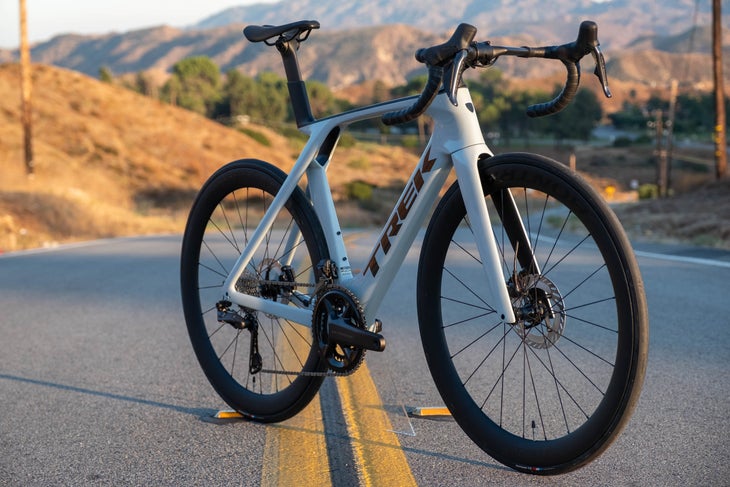
The differences are subtle, but the most impactful is the new Trek Madone SL Gen 7 uses Trek’s 500 series OCLV carbon. Really, that means it is a slightly heavier composite that adds weight but also increases durability. The Trek PR for the new Gen 7 SL is claiming “nearly 300 grams lighter than the bike that came before it.” However, on the weight spec sheet, they claim 1676 grams for a painted frame and fork, while the Trek website says the Gen 6 SL frameset is 2120g. That is a difference of 444 grams.
No matter which way you look at it, they have cut weight. My size 56 Madone SL 7 Gen 7 test bike hit the scale at 17.68 pounds. It is the higher spec of the two versions offered. Trek said they have decided to consolidate models for this generation and are only offering the SL with either Shimano Ultegra or 105. It is also worth noting that the frameset is electronic shifting compatible only.
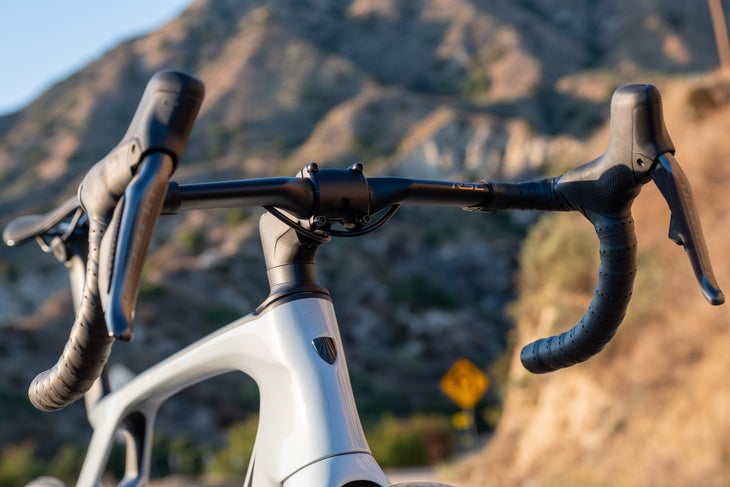
The next biggest difference from the SLR is that the SL uses the Bontrager flared RSL aero handlebar along with the RCS Pro stem rather than the one-piece cockpit. This means the brake hoses are exposed as they leave the headtube and under the stem. If I am being completely honest, I prefer this two-piece option, and it makes it much easier to adjust fit. Not to mention that shipping the bike or airline travel bike bags is much easier to fit into.
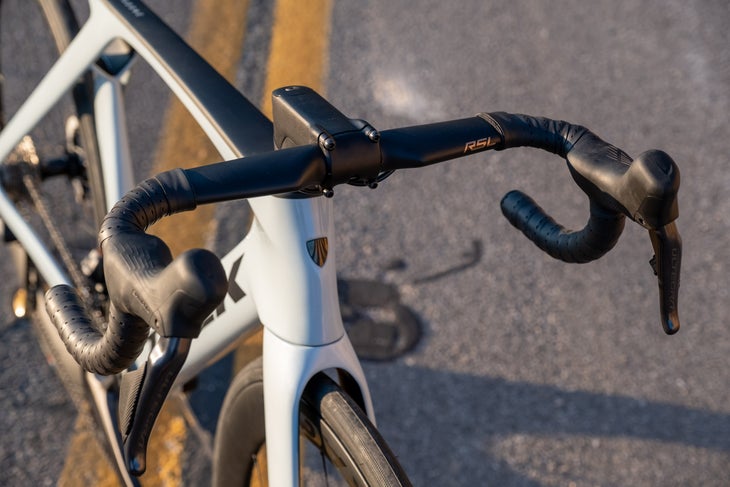
What’s the deal with IsoFlow?
Trek is claiming two major things with the under-seatpost opening. First is improved airflow, and the other is comfort. While airflow is hard to validate without a wind tunnel and a lot of calculations, comfort is something we can all experience. Beyond that, Trek says that IsoFlow is tuned to balance aerodynamics, weight, and comfort across all frame sizes. For me, it seems like the best place to put a burrito for the spin back home after a solid ride.
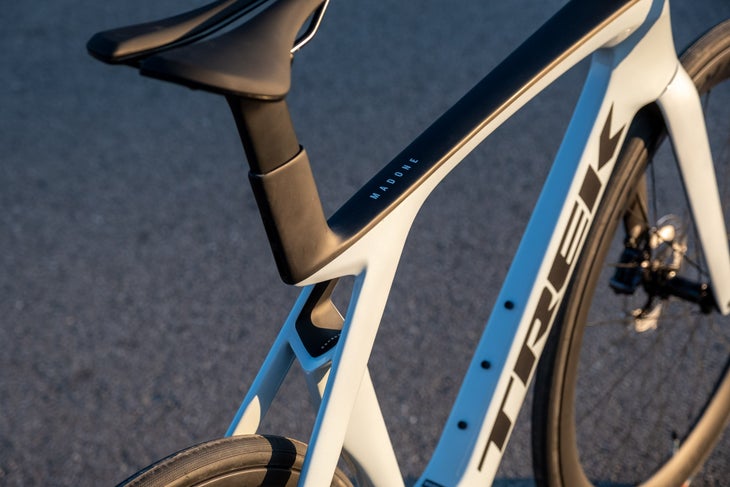
This unique design is where I found myself in a tough position. The seatpost only offers 6.5cm of adjustment up and down. Trek offers two seatpost lengths, meaning that each size technically has a 10cm adjustment. I received the longer of the two seat posts, and it seems that the claimed lowest height for a size 56 is about 5mm higher than the geometry sheet says.
With limited time between receiving the bike and its launch date, I let a few of my trusted riding mates have a go on it since they are a bit taller than me. I did have a few rides on it using my offroad pedals and shoes since they have a taller stack. The saddle was still a bit higher than I prefer, but I agree with the feedback that I received from the others.
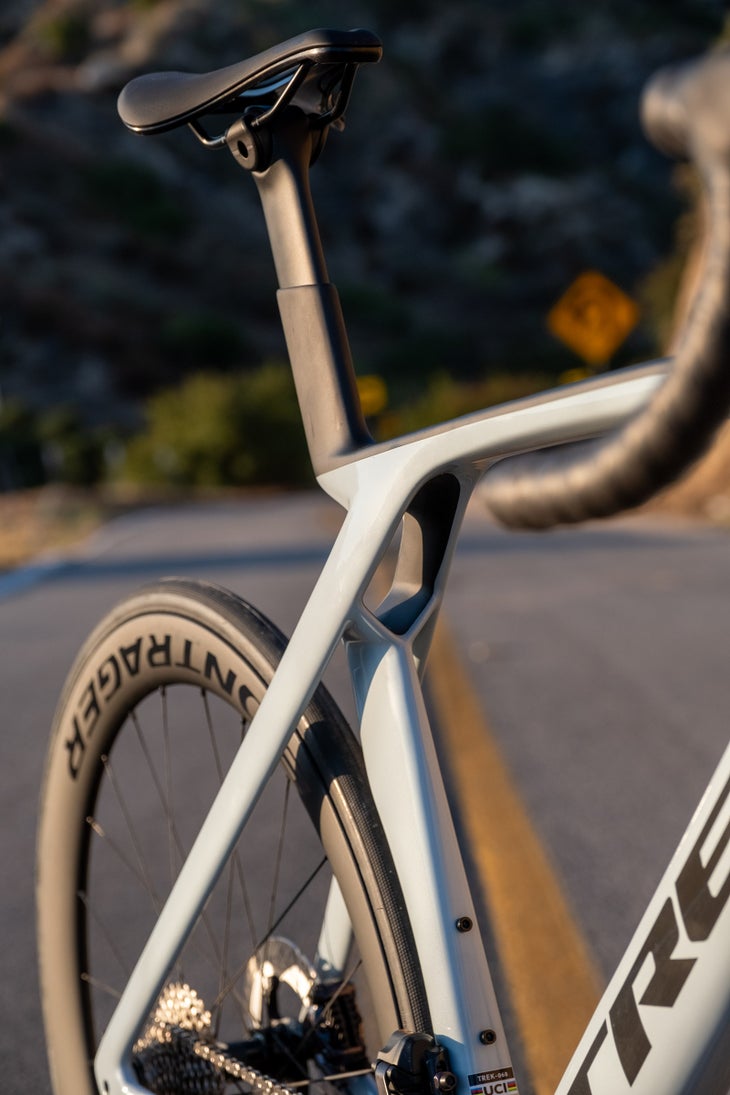
The Ride Experience
The Trek Madone SL 7 Gen 7 is, without a doubt, a performance bike with performance geometry. While that can mean a lot of different things to different people, The SL uses the same race-oriented H1.5 geometry as the SLR. For us, it is responsive but not hyper-responsive. This makes riding in groups easy while also allowing an experienced rider the ability to push the limits in corners.
Less experienced riders will still enjoy the stability and predictability of the bike, but if a mistake is made, you will know it. This sort of modern performance geometry makes race bikes much more versatile and fun for the general rider, and in my opinion, is a great balance for most riders looking for a performance feel from a road bike.
The overall feel of the bike is fast, but the Madone SL seems to do a pretty good job of muting the road feedback. Bigger road imperfections are still impactful and a bit jarring. I normally like a bike with these aspects, but for some reason, there is still a mentality in the performance road segment that if it’s comfortable and smooth, then it’s slow. The Madone seems to balance this fine line well.
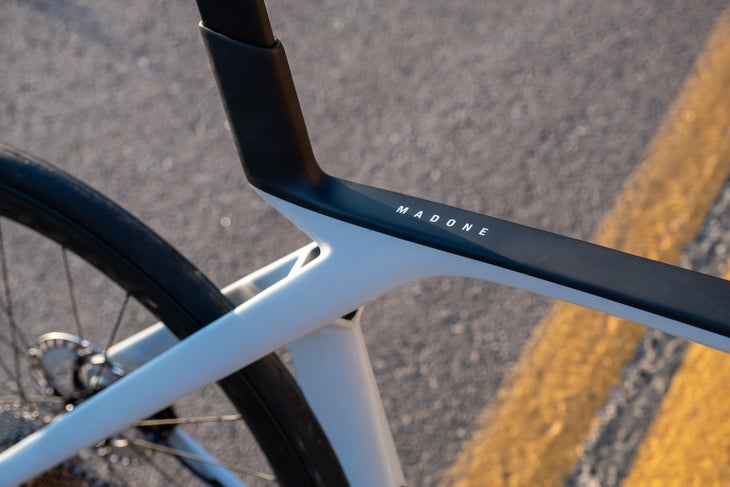
Cornering is responsive yet stable at both high speeds and slower, more technical twists. At 17.68 pounds, it’s not super light, and you feel it most when you are on very twisty roads that require you to quickly transition from a hard left curve to a hard right curve. The bike feels stable, but the weight seems to labor the transition.
You also feel the weight when you are climbing, especially out of the saddle. Don’t get me wrong, it climbs well, but at almost 18 pounds with pedals and all the rest, it’s not a featherweight.
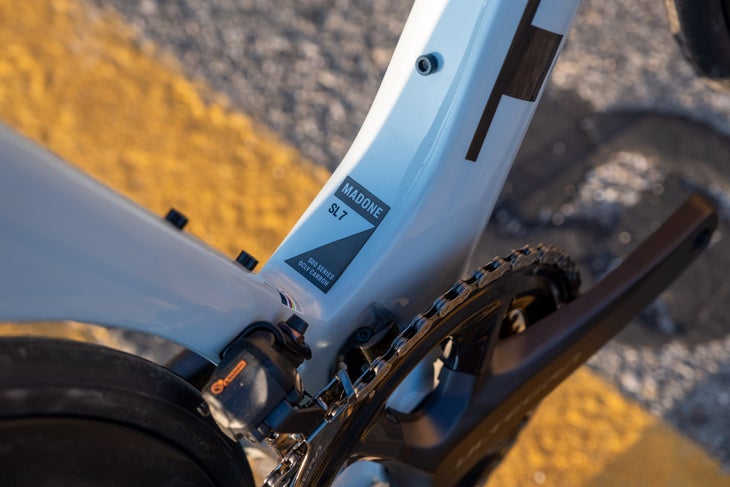
The lateral stiffness and pedaling efficiency seem very good, so a lighter set of wheels would probably transform the entire ride. The stock Bontrager Aeolus Pro 51 wheels have a claimed weight of 1600 grams. That isn’t bad for wheels this deep, but I have a feeling that is a wheelset weight that is not ready to ride and will still need rim tape. If you want to go tubeless, you will need to purchase valves separately and get tubeless-ready tires.
The Good and Bad
As we look closer into the specs of the bike, there are some key aspects that I like and don’t like. First and foremost, I like that Trek has included the required headset cover in the headtube measurement on the geometry chart. The carbon frame measures 13.4cm, but with the cover, it’s 15cm. It seems like a small detail, but I appreciate it.
The next is that just like the SLR, Trek is using a T47 threaded bottom bracket. Historically, Trek used a proprietary bottom bracket that complicated getting parts and fitment. The T47 interface is dependable, easy to work on, and has extensive compatibility. Once again, it’s not a game changer, but the small things make all the difference.
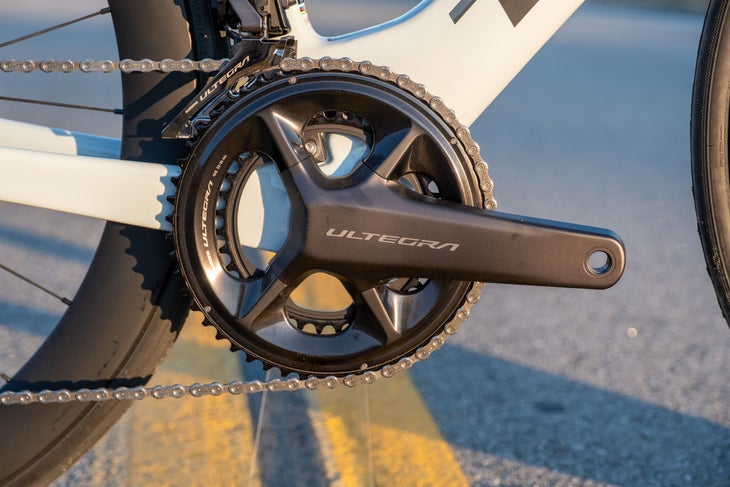
My seatpost length and fitment issues aside, the interface and adjustment of the seatpost is easy. Trek explicitly says not to use carbon grease on the post, and we haven’t had any issues. The wedge system is retained by the seatpost, so no worry of dropping it into the frame. The simple 4mm Allen tool through the slot in the frame means that even a compact saddle bag tool could be used.
Okay, now for the not-so-good. Trek is one of the largest bicycle brands, but they are missing a few key aspects when it comes to a bike performance bike at this level. $5,500 and $6,500 is a lot of money, at least in my household, for a bike. So why are the tubeless wheels that come on both of the SL models not complemented with tubeless tires? This is a performance bike, and road tubeless has been proven to be the fastest choice.
Sure, the Madone SL 6 Gen 7 comes with Bontrager Aeolus Elite 50 wheels that only have an internal width of 19.5mm, but they are tubeless-ready. The version I am testing comes with the Bontrager Aeolus Pro 51 wheels with a 23mm internal width. Why is it that Trek is pairing both models with the non-tubeless Bontrager R3 Hard-Case Lite tires in size 25c and tubes in 2023-2024? The bikes don’t even get shipped with the tubeless conversion parts.
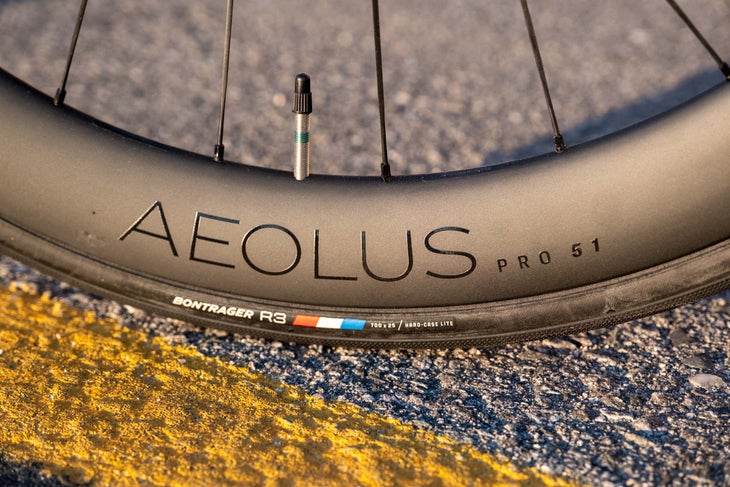
While I like the idea of consolidating the Madone line, why is there no SRAM build? All of the SLR SRAM builds come stock with a power meter. I think that is a huge added value, and all of the Shimano bikes are missing it. Even partnering with someone like Stages or, better yet, the new 4iiii Precision 3+ power meter with integrated Apple Find My tracking for all of the Shimano bikes.
Overall, There isn’t a lot of “new” with the Trek Madone SL Gen 7, and that is fine. Since the SLR version has had a year in the wild, there have only been a few isolated issues, making it a great platform for the SL level. I love that it has a two-piece bar and stem combo, but I am disappointed that Trek isn’t supporting road tubeless out of the box.
The Madone SL and SLR are competing in a very competitive road segment. The aero-refined bikes remain a top choice for consumers of all levels, and while I can’t say this is a favorite, the simple seatpost adjustment does bump it up on my list. Plus, unlike many of its competitors, almost any 31.8 stem or cockpit will work, major bonus points.
Weight: 17.68 lb, actual weight, 56 cm size, without pedals Price: US$6,499.99 / AU$10,299.99 / £7,500.00 trekbikes.com
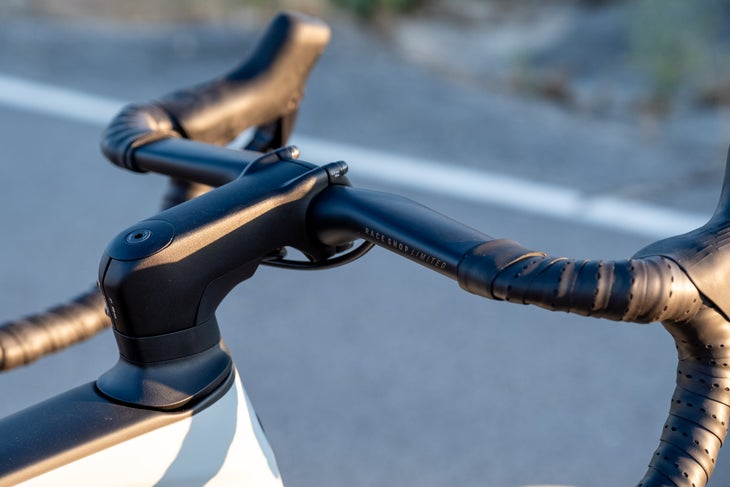
Popular on Velo
What’s it like to be an American cyclist living in France? Watch to get professional road cyclist Joe Dombrowski’s view.
Related content from the Outside Network
One way south, mountain bikers react to their first taste of non-alcoholic craft beer, video review: bmc urs 01 two gravel bike, kiel reijnen vuelta video diary: the painful decision to abandon.
Welcome to Escape Collective. Please select your language.
Please note that this is an automated translation and it will not be perfect. All articles have been written in English and if anything appears to not make sense, please double check in English.
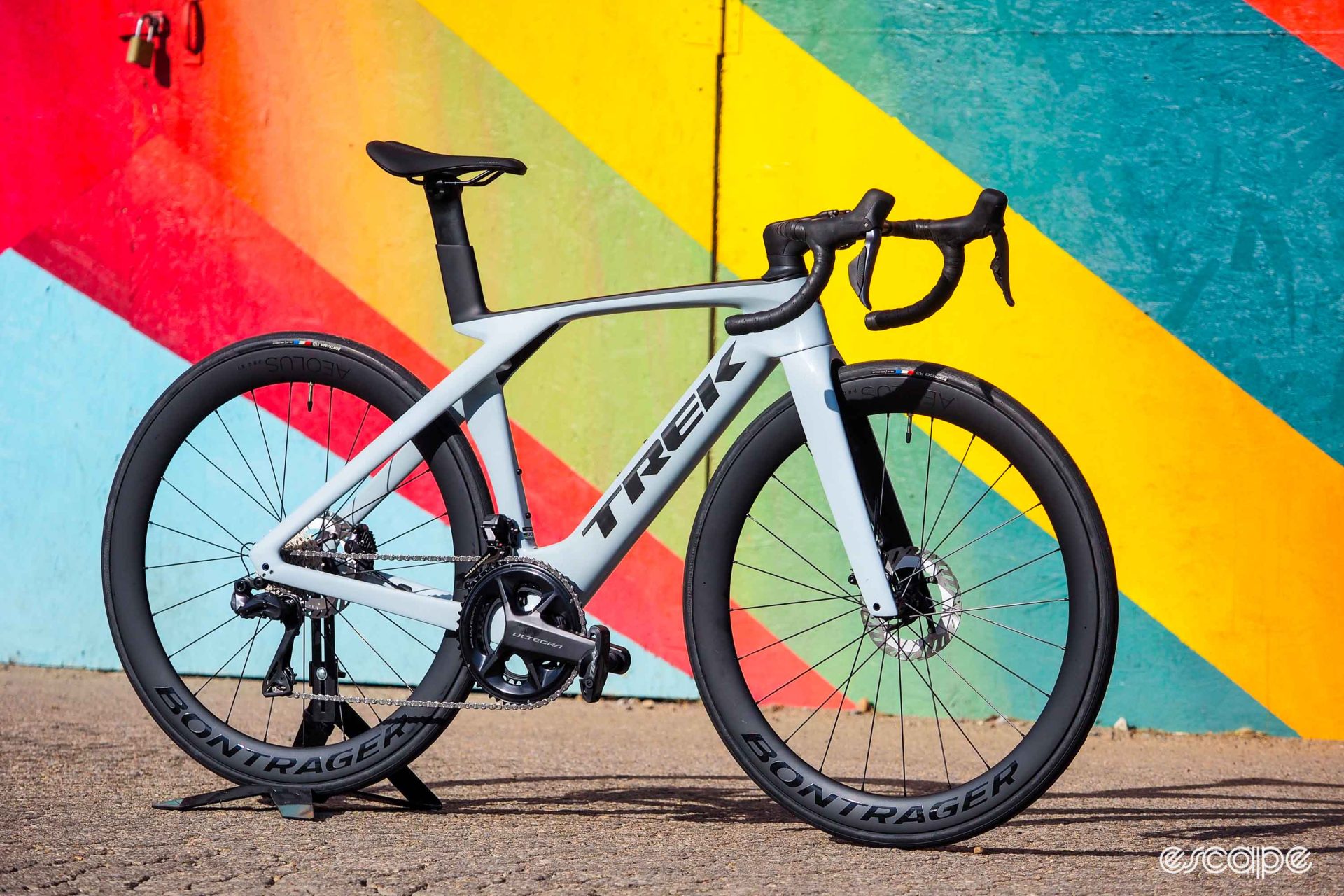
2024 Trek Madone SL 7 review: This is the one to get
The flagship Madone is lighter and very slightly more aero, but also more than twice as expensive.

Second-tier models – ones that look the same, but use less-expensive materials and parts to lower the cost – typically aren’t nearly as exciting as their more premium cousins. But in the case of the Trek Madone SL vs. the Madone SLR, the difference in performance is so small – and the difference in cost so dramatic – that it’s hard not to consider the “lesser” version to be the one to get, even if you have the money for the flagship model.
The short of it: The same cutting-edge aerodynamic performance of Trek’s flagship Madone SLR, distilled into a much more affordable package. Good stuff: Heaps lighter than before, tangibly speedy, surprisingly good ride quality, superb handling, lots of tire clearance, user-friendly two-piece cockpit, sharp lines. Bad stuff: Polarizing IsoFlow aesthetics, poor weathersealing, narrow wheels and tires.
An aero primer
Trek went perhaps a little too far down the “aero and comfy” rabbit hole with the 6th-generation Madone, which was impressive in the wind tunnel and surprisingly comfortable to ride, but also among the heavier options in the category what with its complicated (and hefty) IsoSpeed pivoting seatmast design. With the latest iteration of the Madone launched last June, Trek supposedly improved the bike’s aerodynamic performance while also simplifying the structure, ditching IsoSpeed in favor of an even more radical-looking seat cluster configuration called IsoFlow.
In short, IsoFlow comprises a giant hole where the seat cluster would normally be. The seat tube stops just shy of its normal height, the seatstays bypass that area entirely and connect further forward on the top tube, and the semi-integrated seatmast is now cantilevered off the back of the top tube like the business end of an ice hockey stick.
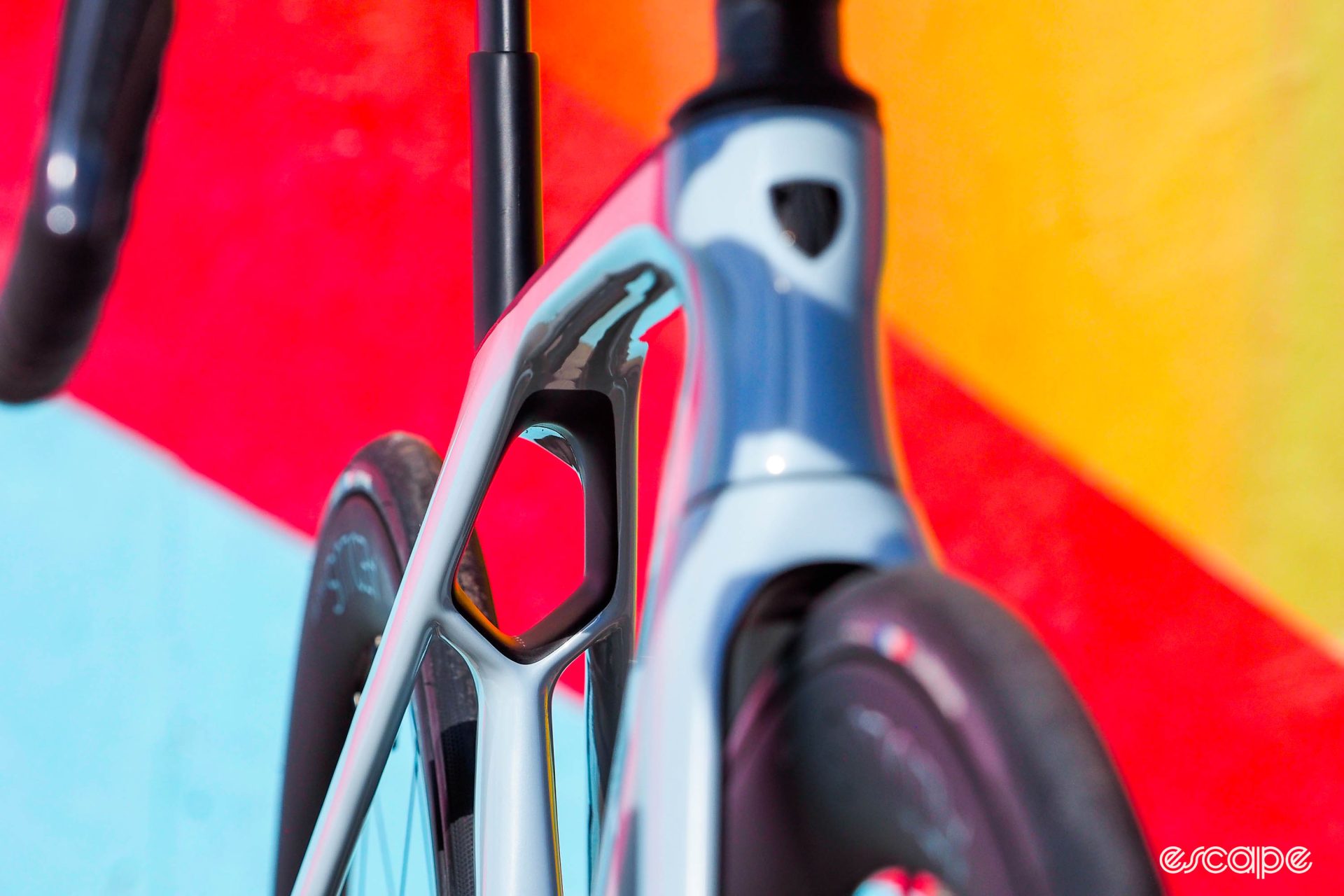
Trek claims IsoFlow yields smoother airflow through that area, saves almost 150 g relative to the outgoing Madone (for the flagship SLR trim, at least), and – thanks to some clever carbon tuning in that area – also supposedly provides a better ride quality than you’d otherwise expect from such chunky frame proportions.
Trek has been one of the biggest proponents of Kamm-tail tube profiles since first using it on the Speed Concept way back in 2009, and those flat-backed shapes are very much alive and well on the latest Madone – if anything, they’re deeper than ever thanks to recent revisions in the UCI technical guidelines. The down tube, seat tube, seatstays, and fork blades are all more aggressively shaped than ever, and the head tube and cockpit areas are particularly sleek so as to keep air flowing cleanly over the carefully sculpted surfaces.
The revised frame shape only accounts for about half of the new Madone’s claimed aerodynamic performance gains, however. The other half comes from the rider – or, more specifically, handlebars that have been radically narrowed by about 3 cm across the board in order to place the rider in a more aerodynamic position.
Taking all of these factors together, Trek is touting some bold performance gains, saying the 7th-generation Madone frameset module (including the frame, fork, cockpit, and seatpost) is not only about 300 g lighter in total than the 6th-generation one, but also about 19 watts more efficient aerodynamically in a wind tunnel (at 45 km/h), which Trek says translates to a 60-second advantage per hour at that speed.
A single letter with small differences
All of those changes sound well and good, but keep in mind that when those announcements were made in June 2022, they only applied to the flagship Madone SLR models, whose retail prices start at US$8,000 / AU$11,800 / £7,600 / €8,200 (for a Shimano 105 Di2 build!) and top out at a whopping US$13,200 / AU$19,000 / £14,500 / €15,700 with a SRAM Red AXS groupset. More power to you if you can swing that kind of cash, but for most performance-minded riders, that’s just not in the cards.
Trek has for years offered a less-expensive version in the Madone SL, but given how the 6th-generation Madone SLR was already overweight, the Madone SL was a veritable boat anchor. For example, a sample I tested a couple of years ago with a mid-range SRAM Force AXS wireless groupset and Bontrager’s reasonably light Aeolus Pro 51 wheels came in at a whopping 8.59 kg (18.94 lb), a tough pill to swallow, aero advantage or not.
Thankfully, the weight loss plan introduced with the Madone SLR now also carries over to the recently updated Madone SL. Despite the lower-grade carbon fiber blend here, claimed weight for a 56 cm Madone SL frame is now 1,200 g, plus 476 g for the matching fork. That’s still 208 g more than a comparable Madone SLR frameset, and hardly a featherweight given the selection of sub-800 g options now on the market, but still pretty good all things considered. If you take Trek’s aero claims at their word, those extra grams aren’t going to matter much at all against the stopwatch on most courses, and realistically speaking, the person considering a Madone these days will probably be more concerned about grams of drag.
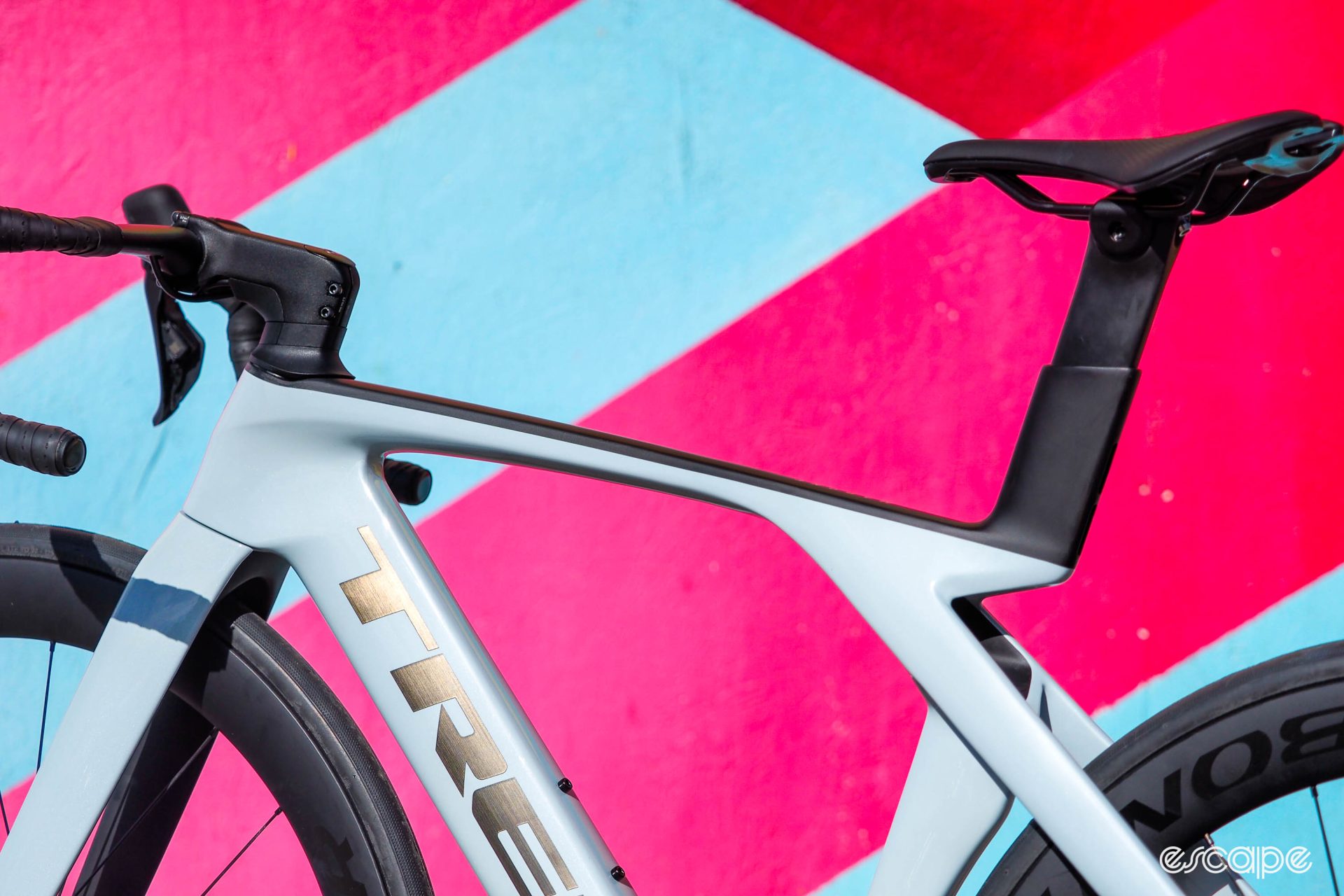
Like with the previous Madone SL, this one again uses the exact same shape as the Madone SLR, so its aerodynamic performance should be identical, with one exception: the cockpit. The Madone SLR uses Trek’s latest one-piece carbon fiber handlebar/stem, but the Madone SL uses a more conventional two-piece setup that includes an aero-focused forged aluminum stem with a separate aero-shaped carbon fiber handlebar. And whereas the hose routing on the Madone SLR is fully internal, it’s hidden – but still largely accessible – on the Madone SL, with the brake hoses peeking out just a bit underneath the bar clamp before ducking away again into a plastic shroud bolted to the underside of the stem.
Trek says this equates to a six-second hit to the Madone SL’s aerodynamic performance relative to the Madone SLR. Don’t worry; I’ll get to that soon enough.

Trek also says there’s a negligible difference in chassis stiffness – less than 5% – and ride quality shouldn’t take much of a hit, either. If anything, the lower grade of carbon fiber in the Madone SL might even make that bike more comfortable than the Madone SLR, not less.
Aside from the different carbon fiber blend and the two-piece cockpit, the rest of the feature list is identical, including Trek’s slightly modified T47 oversized and threaded bottom bracket shell, a built-in chain keeper, and the brand’s now-signature semi-integrated seatmast. Unlike true integrated seatposts, though, this one doesn’t have to be cut and will still squeeze into most standard travel cases, and Trek has gone to great lengths to ensure a proper rider fit. If the included proprietary seatpost doesn’t quite accommodate your position, Trek also offers a longer option – each with 65 mm of total height adjustment – and both are available in 0 mm and 20 mm offsets. Given the rather goofy component dimensions, Trek thankfully has a broad range of dedicated front and rear accessory mounts to accommodate stuff like lights and computers, too.
Both versions are also offered in eight sizes: impressive for a mainstream brand.
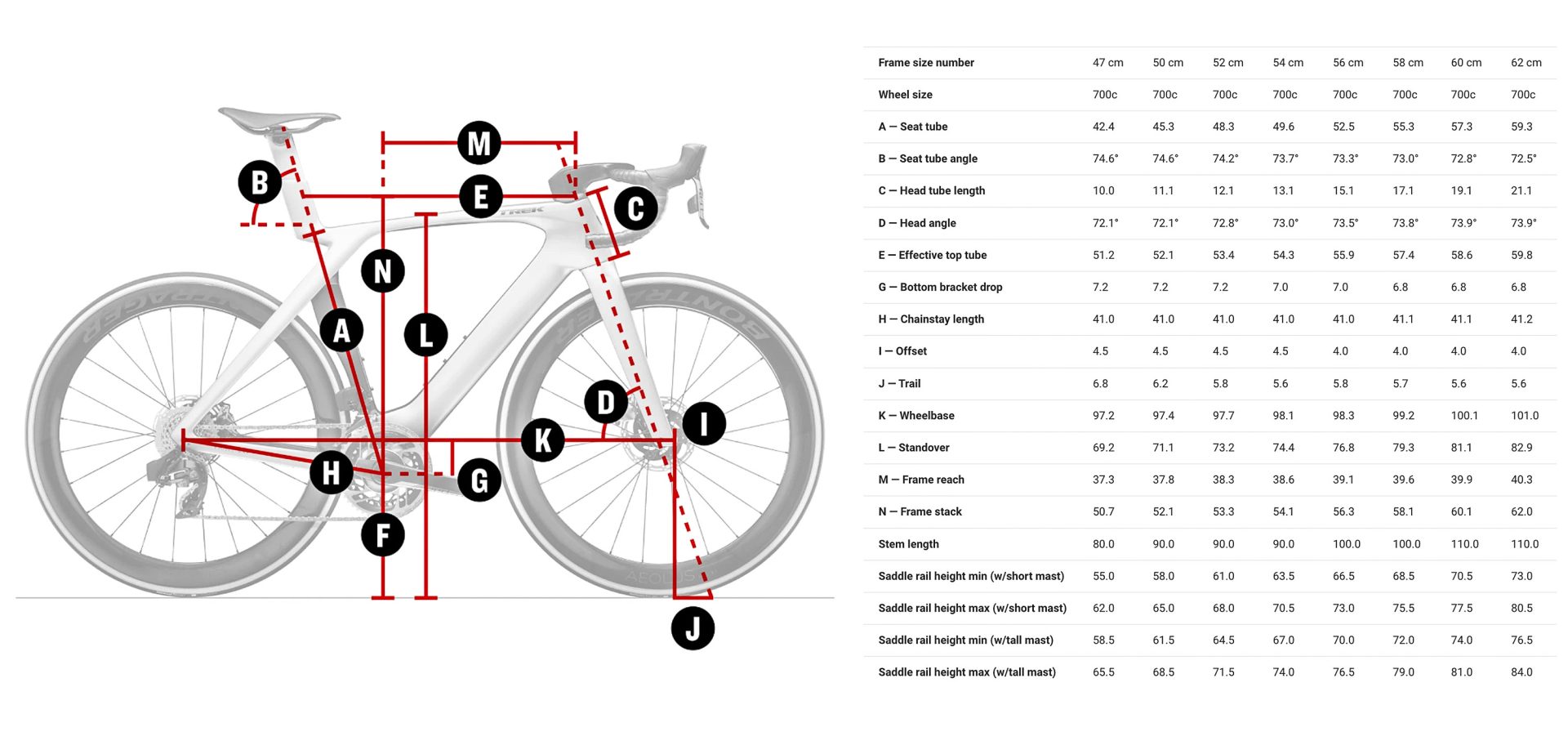
Otherwise, the differences between the Madone SL and Madone SLR simply boil down to more economical build kits.
My Madone SL 7 test sample is the nicer of the two complete Madone SL bikes Trek offers currently, and comes equipped with a complete Shimano Ultegra Di2 2×12 wiredless electronic groupset, Bontrager Aeolus Pro 51 carbon fiber clincher wheels wrapped with 25 mm-wide Bontrager R3 Hard-Case Lite tires, a Trek RCS Pro forged aluminum stem, Bontrager RSL Aero carbon fiber handlebar, and a Bontrager Aeolus Comp snub-nosed saddle.
Actual weight for my 52 cm sample is 8.01 kg (17.66 lb), without pedals or accessories, and retail price is US$6,500 / AU$10,300 / £7,500 / €8,000.
You know what feels fast? Money left over in my pocket
Having fun on a road bike largely revolves around going fast – and holy cow, is the Madone SL fun in that respect.
For however many full-blown aero road bikes I’ve ridden over the years, it’s still shocking every time I get on a particularly good one and can so immediately feel – feel! – how much faster they are. It’s startlingly easy to hit – and hold – high speeds, but it’s also tangibly easier to just casually cruise if that’s what you feel like doing that day. The beauty is that the option to go fast is always there if you want it, and even after however many years I’ve done this, that thrill never goes away.
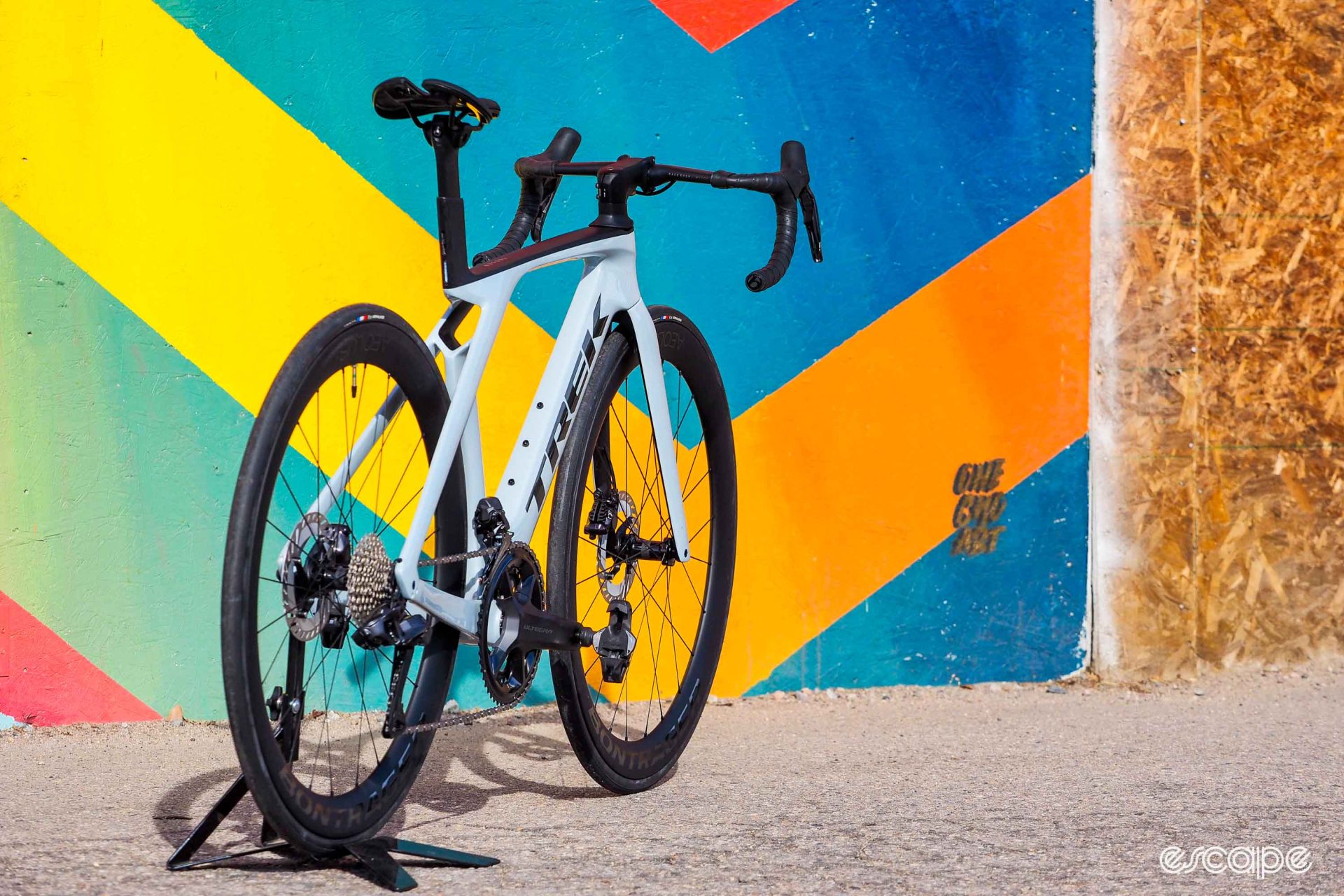
Those huge tube sections and all that material are also put to good use in terms of chassis stiffness. It’s wonderfully responsive when you lay down the watts, and it feels every bit like the race bike it’s supposed to be. High-speed jumps are where the Madone SL excels given that aerodynamic shape, but the combination of that stiffness and the new weight loss make it a surprisingly good partner on steep climbs, too. That rigidity also feels nicely balanced from tip to tail with no section of the frame coming across as more flexible than another. The Madone SL obviously doesn’t feel as light heading uphill as something truly feathery, but sub-8 kg is still pretty darn light, and if speed is truly what you’re after, the aerodynamic benefits should more than make up the difference.
I fully expected my test sample’s 36 cm-wide bars (at the hoods) to feel very weird – and to be fair, they did, but literally only for the first few minutes, after which I almost completely forgot about it. I did miss the additional leverage of my usual 40 cm-wide bars on particularly steep climbs, but that was about it. Consider my eyes opened.

That the Madone SL efficiently cuts through the air and feels fast doing so shouldn’t be a big surprise. The old one was known to be very aerodynamic, and this one is supposedly a big step up from there. But a big aspect of being fast on the road is also being comfortable, and more specifically, that you are able to achieve and maintain an efficient position while also producing a lot of power.
And that’s where the Madone SL’s two-piece cockpit comes in.
One-piece cockpits may look cool, but I don’t always get along with them. Even if the bar width and stem length is correct, sometimes the bend just isn’t my favorite, or the cross-section doesn’t feel right in my hands, or the drop dimension isn’t quite there, or whatever. More often than not, I find myself having to adapt to the bar since there aren’t any other options available instead of the other way around.
The two-piece setup on the Madone SL may be slower than the fancy (and lighter, and far more expensive) one-piece cockpit on the Madone SLR, but being able to easily adjust and tune the front end to my liking is something I find invaluable. In the case of the Madone SL, the stock bar actually worked quite well for me: an appropriately deep drop with a semi-anatomic bend, a nice flat platform behind the hoods to rest your wrists, and tops that are aero-profiled but still refreshingly comfortable to hold.

The stem, on the other hand, was a hair too short given my shorter-legs-longer-torso proportions. On a one-piece setup – particularly one with fully internal routing – even a simple adjustment like that on an internally routed one-piece setup is literally hours of work. And while Trek may offer the fancier one-piece setup in fourteen different size combos, you still have to buy the thing (unless you go through Trek’s Project One custom program and pick the right one from the start). But on the Madone SL, it took me all of ten minutes (and many dealers would likely be willing to swap the stem for you). Oh, you also want to try lowering the stem for a bit before cutting the steerer? Just stack some totally normal round spacers on top for a bit. Brilliant.
Such simple things shouldn’t be so refreshing, but these days, they are.
Speaking of comfort, the Madone SL rides much better than I’d expected. While the ride quality is on the firmer side, it’s very well damped and also effectively takes the edge off of bigger impacts. Tactile feedback is still superb, too, and it’s striking how well the front tire communicates grip levels through the bars without feeling harsh. And as much as I enjoyed the cushiness of the old IsoSpeed system, I have to admit that there seems to be something to Trek’s claims about how the IsoFlow mast flexes over bumps. I’m not sure what it’d feel like under someone appreciably heavier than my modest 72 kg (159 lb), or how well that sort of cantilevered arrangement will hold up over time, but I’ll be damned if it isn’t impressively comfy.
If you are after an even softer ride, don’t forget there’s room for tires with a measured width up to 33 mm – or even more if you’re willing to stomach the risk of running less than 4 mm of clearance at the chainstays.

Handling is another bright spot, as the Madone SL feels much like every other Madone I’ve ridden over the years. The steering geometry is quick and incredibly intuitive without ever feeling twitchy or nervous. It initiates turns with but a flick of the wrists and just a little tilt of your hips, falls naturally toward the apex, and then readily snaps back upright when it comes time to rocket out of the corner, never fighting you at all along any point of the process. High-speed stability is fantastic, too, with not a hint of drama – just relax and keep it pointed where you want to go. That magical combination is something I’ve long enjoyed about the Madone, and I hope Trek never changes it.
One change I’m quite fond of, however, is the new Madone SL’s edgier aesthetic. Gone is the incongruent mix of shapes on the previous model in favor of a more cohesive assortment of mostly straight edges. I’m particularly keen on how the seatstays, down tube, top tube, and chainstays seem to form a perfect parallelogram in profile. There’s beauty in the symmetry.
That all said, it’s hard for me to ignore some of the Madone SL’s quirks, too.
Trek has engineered a surprising amount of saddle height adjustment considering the relative stubbiness of that integrated seatmast – not to mention the fact you never need to take a hacksaw to your brand-new bike. But the gap between the seatpost and seatmast base is big and unsightly, and the exposed slots further down are begging to suck in whatever’s flying off of your rear tire.

Trek says that area is entirely sealed off from the rest of the frame so you theoretically shouldn’t be regularly filling your bottom bracket area with gnarly road spray. “You could drain any water that may get in there by tipping the bike upside down, and the material is carbon so there wouldn’t be any damage if water got in,” I was told. Ok, but wouldn’t it be better if it wasn’t so easy for water to get in there in the first place? And sure, the main parts are carbon fiber, but let’s not forget all of the metal hardware that fixes those pieces in place – hopefully not permanently someday. Trek has long demonstrated the ability to mold rubber bits in places like wire and hose ports, so it’s a mystery to me why the seatpost area is left so comparatively unfinished.
Speaking of sealing, just as I’ve noticed on other recent Trek road bikes, the upper headset bearing is perilously exposed to the elements. In fact, there’s enough of a gap between the headset cover and the head tube that you can very easily see the shiny (for now) silver of the upper bearing’s outer race. Trek may very well be using stainless bearings (I didn’t bother to ask), but even if so, that only applies to the races – not the bearing balls – and given the enormous cost and hassle of servicing headset bearings with fully internal routing, I want to see headset bearings be more protected, not less.
“We’ve had a high volume of bikes in the field with this same RCS-stem compatible headset bearing cover with similar clearance to the frame for some time (Gen 4 Domane SLR and SL, for example) and have not seen an uptick in the amount of headset service reported by Trek shops,” explained Trek bike product marketing coordinator Jake Glahn.

Consider the old shop mechanic in me unconvinced.
Build kit breakdown
Trek has outfitted the Madone SL 7 with solid, no-frills component mix and I have few complaints.
I’ve extolled Shimano’s latest Ultegra Di2 12-speed wiredless groupset several times in the past already, and my opinions haven’t changed. Shift performance is superb front and rear, lever ergonomics are excellent, and the brakes are strong and mostly silent, and with superb lever feel. Riders in particularly hilly environments might want to consider adjusting the 52/36-tooth chainrings and/or the 11-30T cassette, but Shimano’s use of a long pulley cage across the board for this latest generation of Ultegra Di2 at least lessens the financial hit.

The Bontrager Aeolus Pro 51 carbon wheels share the same rim profile as the higher-end Aeolus RSL 51 – just with different carbon materials – and the DT Swiss 350-based hubs aren’t quite as nice as the RSL version’s DT Swiss 240-based one, either. As such, they’re essentially a wash in terms of aerodynamics, and while the nearly 200 g weight penalty can be noticeable when sprinting or climbing, it’s not a huge deal in the grand scheme of things.
Perhaps more questionable are the Bontrager R3 Hard-Case Lite tires. The tires themselves are perfectly reasonable for everyday use: decent rolling resistance, reassuring grip (at least in dry conditions), seemingly good puncture protection, surprisingly comfortable ride quality. But with even top road pros moving to 28s and beyond , the choice of 25 mm-wide casings here seems a little behind-the-times, even though the actual inflated width is just a hair over 28 mm.
Bumping up a size would enhance the ride quality even further while also improving cornering grip, and there’s certainly room in the frame and fork to spare. The reduced weight of this latest Madone SL was clearly a big story for Trek, though, and my guess is the product manager didn’t want to add any more. But another likely explanation is the shape of the Aeolus Pro 51 rim, which is currently aerodynamically optimized around that tire size. My hunch is the next generation of Aeolus wheel grows in width, at which point I’m guessing the tire size will grow as well.
“25 mm tires are what’s fastest on our current lineup of 23 mm internal-width rims,” Glahn said. “Further, 25 mm tires on 23 mm internal-width rims are what was used in the wind tunnel testing for the Gen 7 IsoFlow Madone, and therefore contribute to the basis of our aero claims for this platform.”

As for the Bontrager finishing kit, the Aeolus Comp saddle is one of my favorites: a sort of hybrid between a Specialized Power and a Pro Stealth, mixing the overall profile of the former with the wider nose of the latter. It seems hard at first, but the high-density padding offers excellent support that arguably gets better as the hours tick by.
I know I’ve already mentioned this, but the Bontrager RSL Aero handlebar was a pleasant surprise. The narrow width is initially jarring, but the overall shape is very comfortable, and there’s excellent wrist clearance when you’re in the drops. Kudos to Bontrager for not merely following trends and slapping a shallow drop on this thing, too. It’s an aero bar meant for performance riding, and so the 80 mm reach and 124 mm drop strike me as just about right. I do wish Bontrager had included more room in the middle for a computer mount, though. Unless you’re running something with a particularly narrow clamp, you’re stuck with some sort of stem-based computer mount.
It’s a winner for me
I haven’t always been a fan of the Madone SL in recent years. Although I loved the aerodynamic performance, it was just too darn heavy. Now that Trek has lopped so much weight off of it, though, it’s not only become much more appealing in my view, but also arguably the one to have if only for that more livable two-piece cockpit design.
If you’re on a budget, yes, there’s also the Madone SLR 6 that comes with Shimano’s new 105 Di2 wiredless electronic groupset, which would more closely align with the old “buy the best frame you can afford” mindset. The complete bike is about 250 g lighter overall than the Madone SL 7 despite the groupset being 130 g heavier, comes with the same wheels, shift quality would be virtually identical, and if the mid-compact gearing of the Madone SL 7 seems a little too tall for your liking, the 105 setup includes a friendlier 1:1 ratio for clawing your way uphill.
But the braking performance of 105 isn’t quite as good as Ultegra, you can’t add remote shifters, and the supplemental upper buttons on Ultegra and Dura-Ace that are so handy for things like controlling your computer are missing, too. And then there’s that potential fit and comfort issue of that Madone SLR’s one-piece front end I’ve already mentioned, plus the Madone SLR 6 is still US$1,500 more expensive.
Get the best frameset you can afford, sure. But when the second-tier one is this close, I know which one I’d be buying.
More information can be found at www.trekbikes.com .

What did you think of this story?
😐 Meh 😊️ Solid 🤩 Excellent
Read Comments
escapecollective Trek
Trek Madone Gets More Affordable with All-New SL Gen 7 and RSL Aero Bar
While still expensive, the new bike is thousands less.
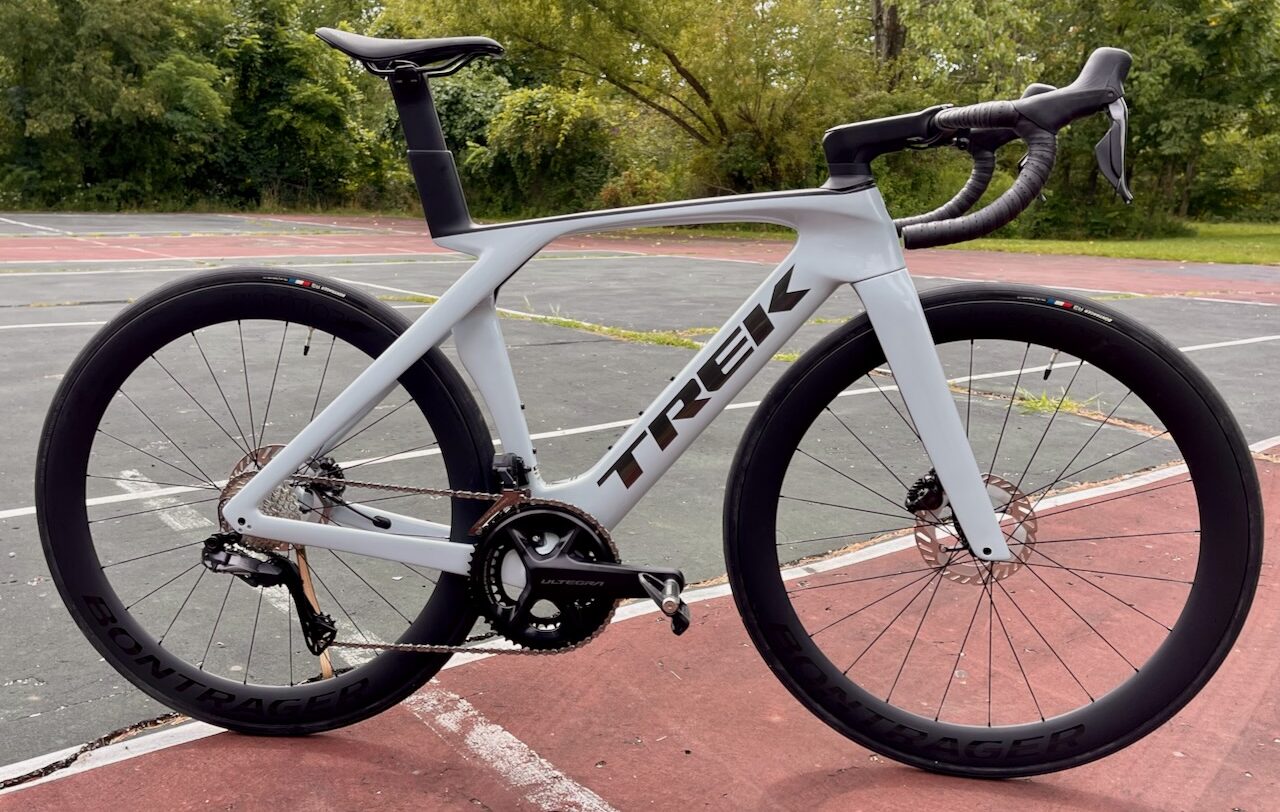
- Click to share on Facebook (Opens in new window)
- Click to email a link to a friend (Opens in new window)
Want to go fast for less? Trek’s new Madone SL Gen 7 looks to deliver SLR performance at a (much) lower price point. The new Madone SL Gen 7 frame looks nearly identical to the SLR, with only a few tweaks and a brand new RSL Aero Bar.
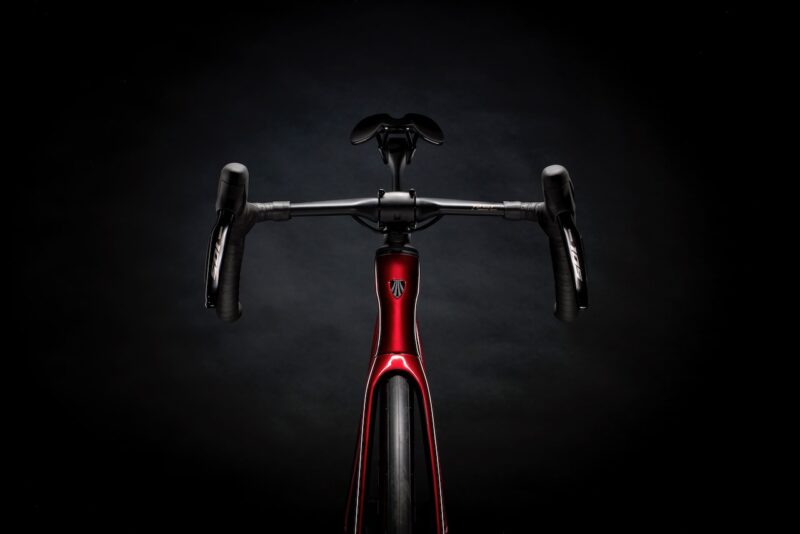
The question is: Do you want a Trek Madone SL Gen 7 for $2550 less than the SLR Gen 7, or do you really need to save 300g?

Trek Madone SL Gen 7 — Frame details:
The Trek Madone SL Gen 7 has (almost) all the bells and whistles of the Madone SLR and is available at nearly half the price.
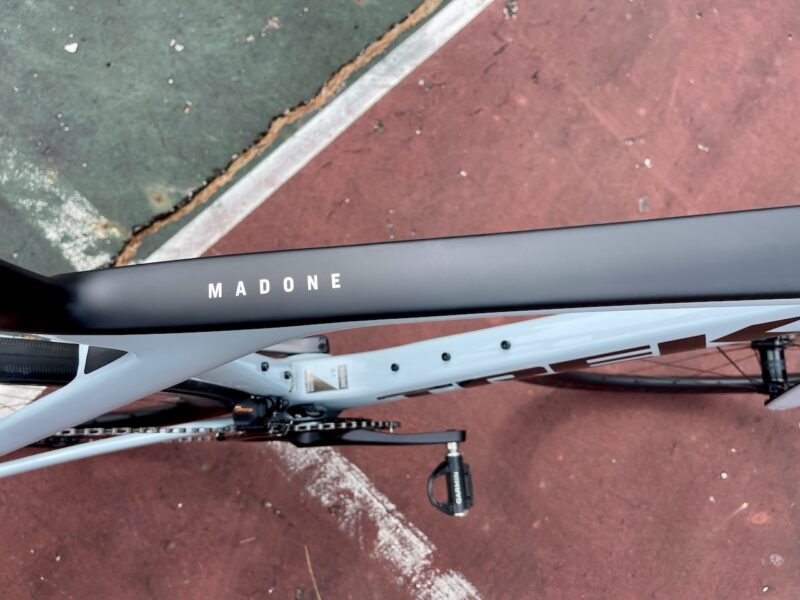
What are the bells and whistles? The Trek Madone SL Gen 7 frame takes cues from the Madone SLR, including the new IsoFlow design. This unique hole in the frame’s seat tube replaced the IsoSpeed damping system on the previous Gen 6 version.
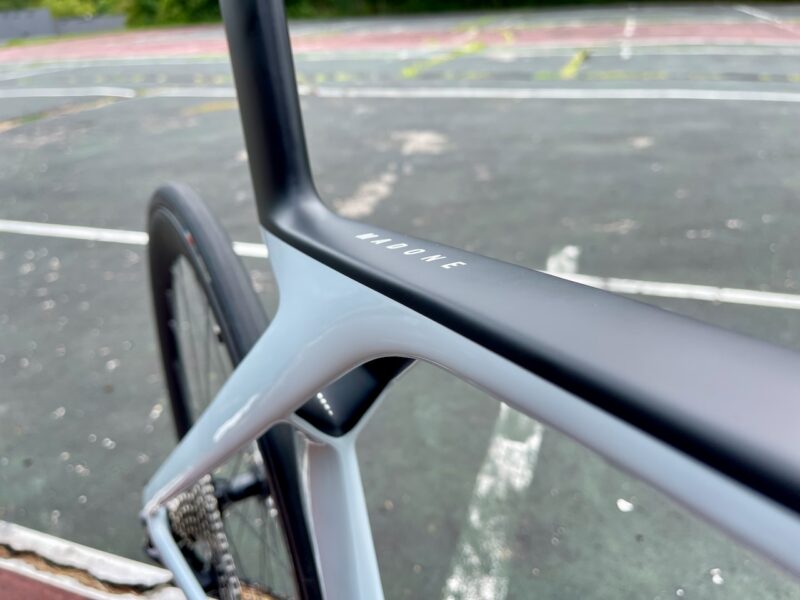
The new IsoFlow system still provides some vertical compliance, but more impressively, it eliminates excess weight and is a claimed 60 secs faster per hour over the Gen 6 model.

The slippery frame combines a refined Kammtail (Kammtail Virtual Foil) shaping for the tubes and a new narrower handlebar. Trek claims the new narrower bar/stem saves 9.7w alone, not including the frame aerodynamics.
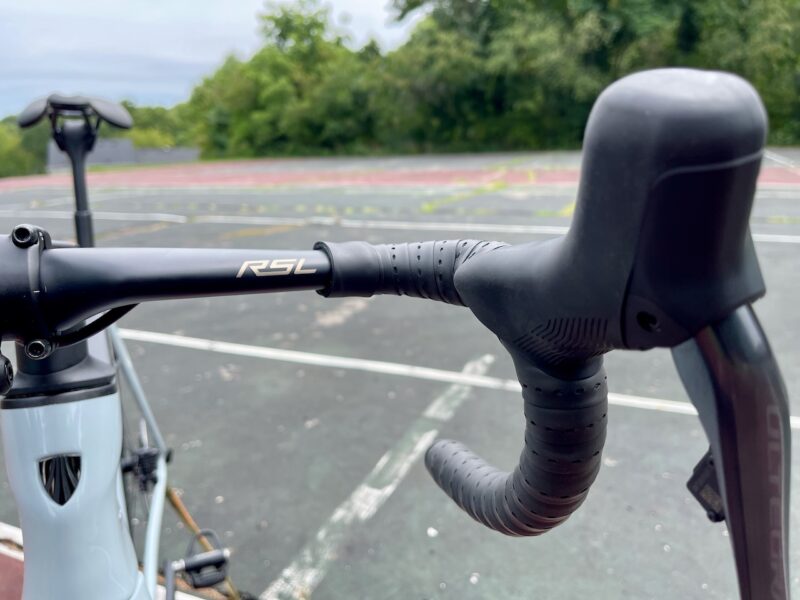
The Madone SLR arrives with the RSL bar stem combo, and the Trek Madone SL Gen 7 mimics that with an all-new RSL Aero bar.
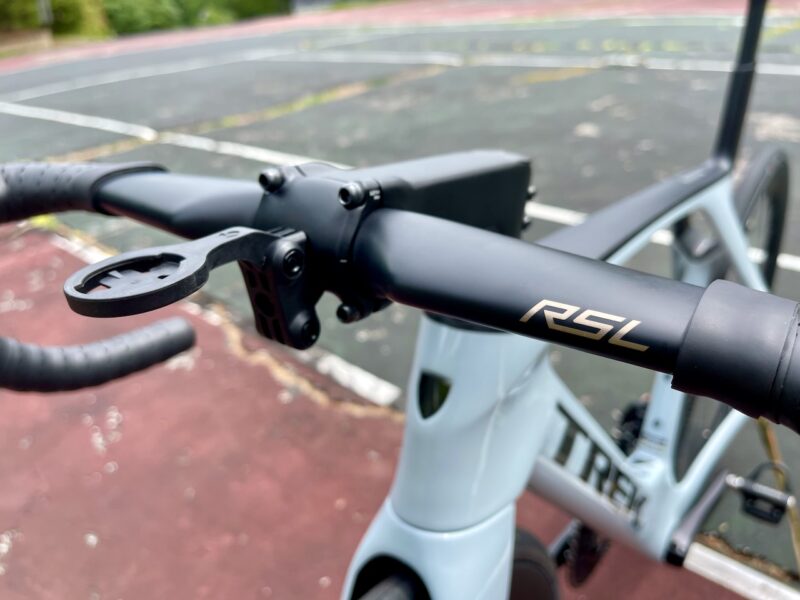
All-New Bontrager RSL Aero Bar
The new Trek RSL Aero bar is a narrow road bar aimed at creating a slippery front end without the fixed limitation positioning of a bar/stem combo.

It’s shallow (124mm drop) with an 80mm reach and a slight flare in the drops. The top of the RSL Aero bar is narrow, 3cm narrower at the tops vs. the drops.
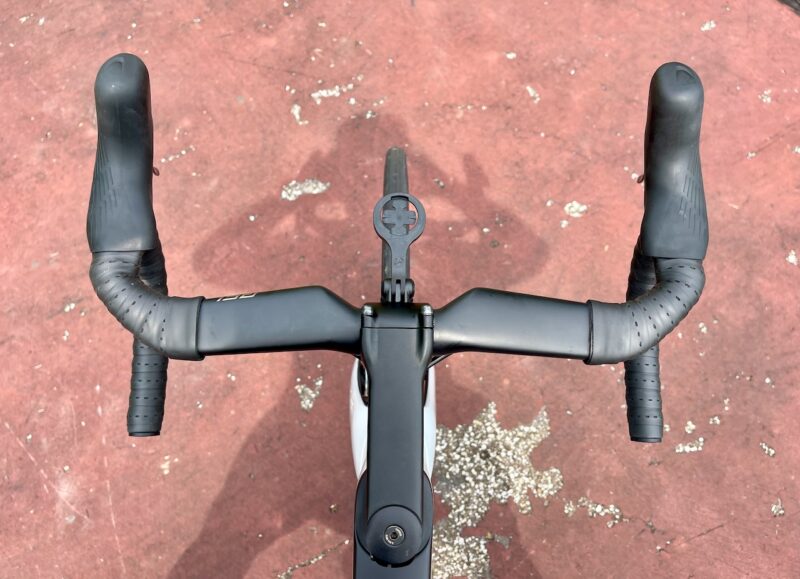
Trek measures the RSL Aero bar from the tops, so finding your size can be tricky if looking aftermarket. For example, a 42cm wide bar is 42cm wide at the drops, which means the tops where the shifter mount are 39cm.

Q: So What’s Different? A: Carbon
The new Trek Madone SL Gen 7 uses 500 Series OCLV carbon fiber, Trek’s middle-tier carbon. The SLR uses 800 series OCLV carbon for maximum weight reduction. You can also find the more robust 500 series on the Trek CheckPoint SL and Domane SL.

The frame bits remain the same (excluding the carbon) and they include a T47 threaded bottom bracket and proprietary seatpost. The seatpost wedge assembly is reversible to allow for a larger range of saddle height adjustment on a single seatpost. The stock seatpost is a 0° offset, but aftermarket 20mm offset versions are available from Trek.

Trek Madone SL Gen 7 Geometry
The Trek Madone SL Gen 7 uses the same race-oriented H1.5 geometry as the SLR. H1.5 is Treks Pro-Tour level race geometry, but it’s not point-and-shoot. Most roadies should find the steering and corning precise but manageable.
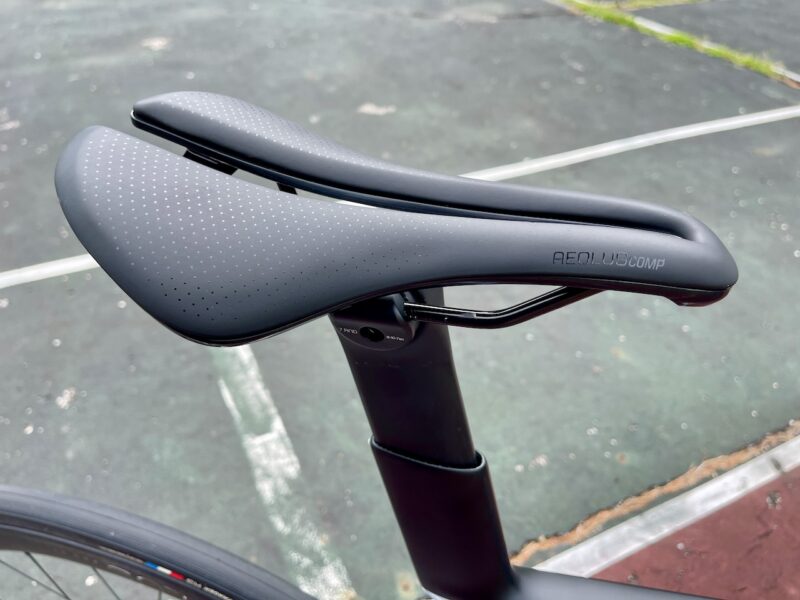
The sizing covers an extensive range, starting with 47cm and growing to 60cm. The seat tube shaping can make for some challenges, so there are two different seat masts, one with a length of 150mm (short) and 200mm (Tall). The geometry chart above shows the minimum and maximum saddle rail height with both options for every size. Bike sizes 47-54 will ship with the short post installed, and bikes 56-60cm will get the tall.
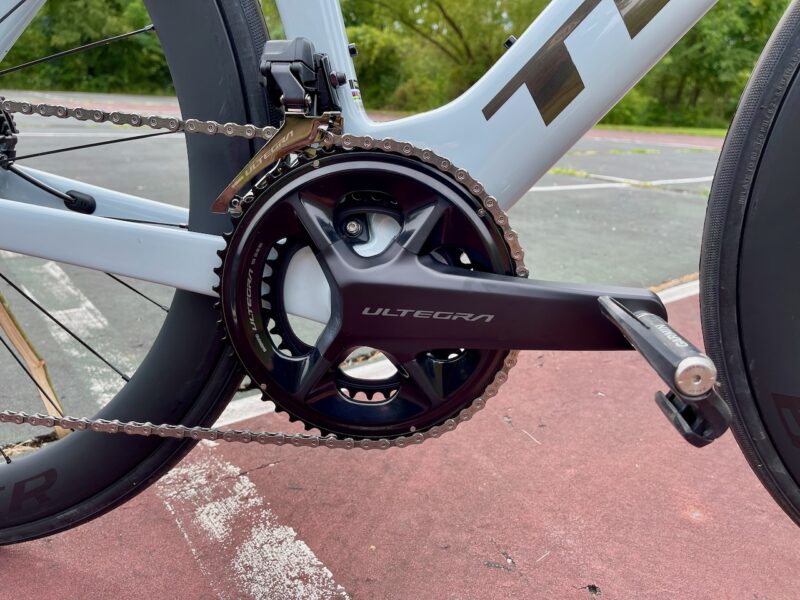
Trek Madone SL Gen 7 Specs:
The new Trek Madone SL Gen 7 comes in two 12-speed Shimano builds: SL7 with Ultegra and SL 6 with 105. Though the groups and price structure change accordingly, a few specs remain the same throughout. SL 7 and 6 come with the cockpit, the new Bontrager RSL Aero-OCLV Carbon bar, and the RCS Pro – 7° stem.
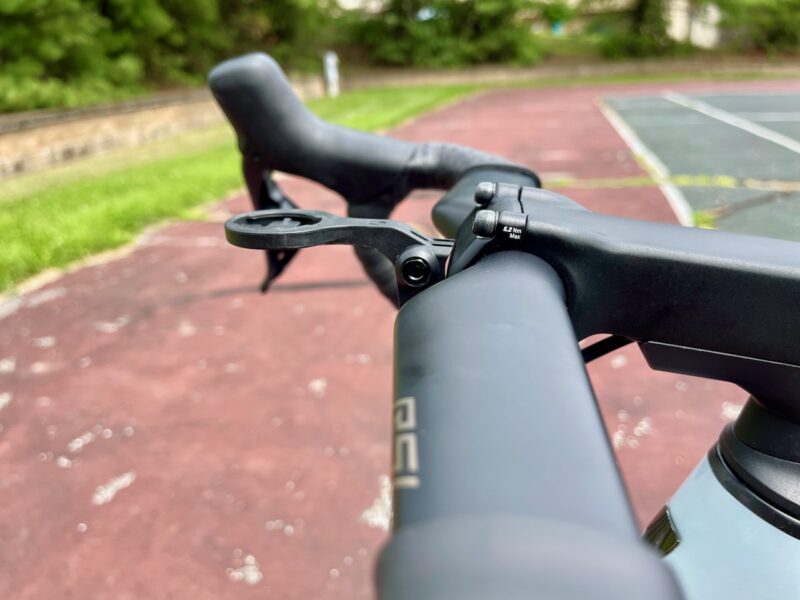
For tires, both roll on Bontrager R3 Hard-Case Lite 120 tpi, 700x25c treads. The 25c tires are narrow compared to most modern road specs but ride well after setting up tubeless. The R3 Hardcase tires are a great mix of high performance with real-world puncture protection, though we prefer the 28c version.
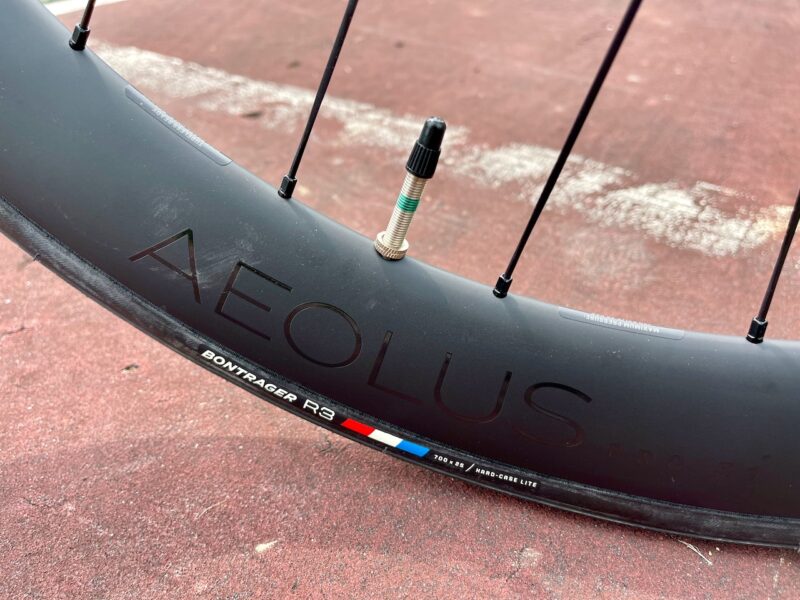
For saddles, the Madone SL Gen 7 comes with the Bontrager Aeolus Comp. We reviewed the Aeolus a while back, and it remains one of our favorites for road riding.

The Aeolus Comp uses steel rails, making it more cost-effective in the spec but keeping the same shape as the Aeolus Pro and Elite — Plus you can use all your Bontrager BlendR compatible accessories.
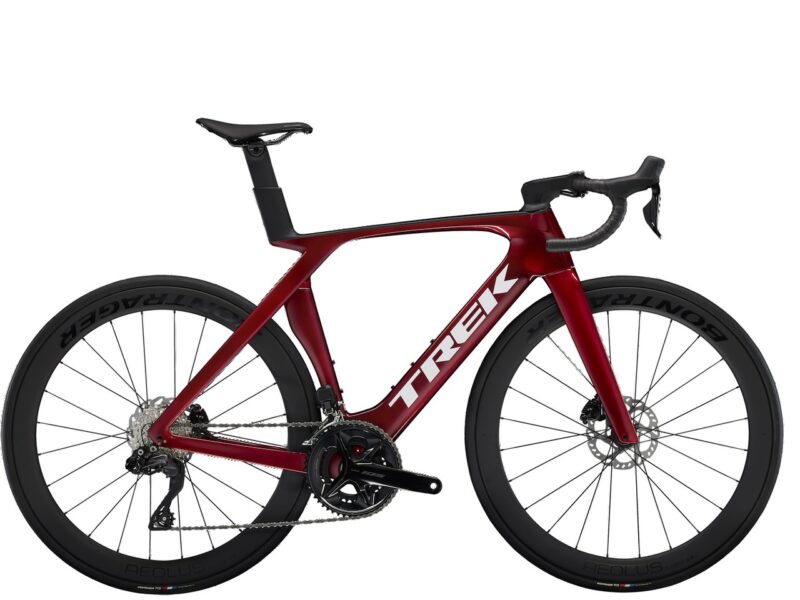
Trek Madone SL 6 Gen 7
- Groupset: Shimano 105 Di2 12-speed, 105 50/34 chainset and Shimano 11-30, 12-speed cassette
- Wheels : Bontrager Aeolus Elite 50 , OCLV Carbon, Tubeless Ready
- Weight: 8.40 kg / 18.52 lbs* Size 56
- Paint: Deep carbon smoke + Crimson
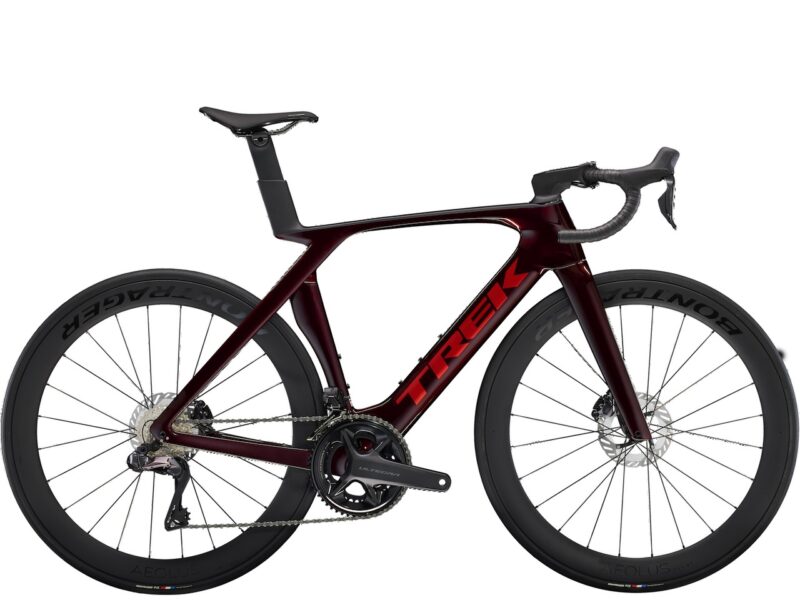
Trek Madone SL 7 Gen 7
- Groupset: Shimano Ultegra Di2 12-speed, Ultegra 52/36 chainset and Ultrgra 11-30, 12-speed cassette
- Weight: 8.00 kg / 17.80 lbs Size 54 (tested, real weight out of the box)
- Wheels: Bontrager Aeolus Pro 51 , OCLV Carbon, Tubeless Ready
- Paint: Dark carmine red + Plasma
Trek Frameset SL7
- Frame, fork, and seat post only
- Color: Dark carmine red

Trek Madone SL Gen 7 Pricing:
- Trek Madone SL 6 Gen 7: $5,499.99
- Trek Madone SL 7 Gen 7: $6,499.99
- Trek Madone SL Gen 7 Frameset: $3,799.99
Trek Madone SL Gen 7 Availability:
The new Trek Madone SL Gen 7 is available online and from your local Trek Dealer. The Madone SL Gen 7 is not yet available for Trek Project One paint, but stay tuned…
Look back for a full review as we take the Trek Madone SL7 Gen 7 through the paces this fall.
Jordan Villella is the Racing Tech Editor for BikeRumor.com, specializing in cross-country mountain, gravel, road, and cyclocross. He has written about bicycles and bike culture for over fifteen years with no signs of stopping.
Before BikeRumor, Jordan raced professionally and wrote for MTBR and the now-defunct Dirt Rag Magazine. He’s covered the World Championships, World Cups, and everything in between — where he loves to report what people are riding.
Based in Pittsburgh, PA, Jordan coaches cyclists of all abilities with Cycle-Smart ; you can find him racing bikes around North America and adventuring with his family.
For an inside look at his review rides follow him on Strava .
This site uses Akismet to reduce spam. Learn how your comment data is processed .
Could you possibly expand on the 300g increase in weight between SL and SLR options?
Are you referencing a frame-only figure or comparing similarly equipped completed bikes? As such, does it include the proprietary seatpost, or handlebar/stem – none of this is known from your article.
Whatever the case, a listed frame weight would add a lot of useful info to this article.
300g must be the frameset. According to the Trek website, the difference between an complete Ultegra-level SL and SLR gen-7 Madone is 0.52 kg.
I second this question!
Were working on getting some frame weights, thanks!
We’re really testing the limits of the word “affordable”
Road cycling is now purely for rich white men these days. Not like back when Lance was winning and people from all sorts of socioeconomic groups got excited and would buy a trek 1.1 to do group rides. Now it’s all people on 5000+ dollar bikes scowling in pastel kit who show up to the ride in their leased Audi. I have a BMW so I’m superior to them though.
There are plenty of very competent aluminum bikes available for a fraction of what this costs, similar to the Trek 1.1 you cite. I agree with Tom below, if you think all road cycling is white men on $5k+ plus bikes then you’re probably not a participant yourself.
Ummm… Caucasians rank pretty far down in a list of ethnicities in the US ranked by household income.
Agreed, though I somewhat applaud Trek’s effort to make the new Madone SL at least more competitive price-wise. I could be wrong but a similarly spec’d Madone SL 7 undercuts Giant’s Propel Advanced SL & Specialized’s Tarmac SL8 Pro by at least $1500 or more.
Still significantly higher than Canyon’s mid-tier Aeroad.
hey, if you want to have instant gratification with the latest hardware, be prepared to pay for it. My road bike cost me $4500, my last one about the same. Just be patient, look for deals, buy used stuff where possible, and it can get done for not an insane amount of money
Applause for a slipper cockpit without the limitations of one-piece bar/stem combos (although those do look purty).
Generalize much? you boys obviously don’t get out much. My big group ride is majority black/hispanic, with a mix of professionals, landscapers, contractors, bus drivers etc.
Yeah, one has to wonder if the commenter that implied that cycling is full of racists is even a cyclist.
FYI the spec for the tires are nontubeless. Whoever is riding the bike better have a good life insurance policy.
If you’re the type that builds custom (because like building a pc it saves money), the 300g is worth $800
If you’re building with new parts, building a frame set up is usually more expensive.
Follow Us On
Subscribe Now
Sign up to receive BikeRumor content direct to your inbox.

- Rider Notes
2023 Trek Madone SLR 7 Gen 7

A carbon frame aero bike with high-end components and hydraulic disc brakes.
Manufacturer Price
Madone SLR 7 Gen 7
In Stock: 54cm
Madone SLR 7 eTap Gen 7
In Stock: 56cm
Madone SLR 9 eTap Gen 7
Madone SLR 7 AXS Gen 6 - 2022, 56cm
Madone SLR 7 Gen 6 - 2022, 56cm
For This Bike
View more similar bikes →
Based on frame geometry and build specs.
A bike with lower gearing will be easier to ride up steep hills, while a higher top end means it will pedal faster down hills.
Similar Bikes
(descending)
Add custom gearing
Based on build material and quality level of the frame, fork, wheelset, groupset, suspension system, and more.
152cm – 159cm
157cm – 164cm
162cm – 169cm
167cm – 175cm
173cm – 181cm
179cm – 186cm
184cm – 191cm
189cm – 195cm
- 181cm, size 56cm, Fits small
- 169cm, size 52cm, Just right

Nov 2023 · Mat Brett
It had its idiosyncrasies – including flip-out 'Vector Wings’ in the head tube – but we wish every new bike offered as many interesting features as the Trek Madone 9 Series did back in 2015
Read Review
Oct 2023 · James Huang
The same cutting-edge aerodynamic performance of Trek’s flagship Madone SLR, distilled into a much more affordable package.
Heaps lighter than before
Tangibly speedy
Surprisingly good ride quality
Superb handling
Lots of tire clearance
User-friendly two-piece cockpit
Sharp lines.
Polarizing IsoFlow aesthetics
Poor weathersealing
Narrow wheels and tires.

Trek's new Madone SL Gen 7 is set to deliver SLR performance at a (much) lower price point. So — is the Madone SLR worth the extra money?
Aug 2023 · Troy Templin
The Trek Madone SL Gen 7 now completes the line matching the more expensive SLR and offers almost the same ride quality.

May 2023 · Simon von Bromley
The seventh-generation Madone is an excellent all-round performer, but it comes with a big price tag
Composed yet fast
Innovative design
Front end can run both integrated and non-integrated handlebar setups
Wide range of frame sizes
No power meter
Mid-range tyres and cheap inner tubes don’t belong on this bike

Dec 2022 · Sam Challis
The new Madone is leaner, meaner and wickedly quick
Very fast ride feel
Smart componentry design
Light weight
Narrow bars take some getting used to
Vulnerable in gusty conditions

Dec 2022 · Julian Schwede
Does the new IsoFlow system of the 2023 Trek Madone SLR 9 eTap Gen 7 really rise the bar in terms of aeroynamics and comfort?
Very balanced handling at high speeds
Reduced complexity and improved aerodynamics of the IsoFlow system
Customisation options thanks to the Project One configurator
High-quality workmanship
The damping of the IsoFlow system isn’t adjustable
The Bontrager R4 tires lack grip

Jun 2022 · Matt Hansen
The frame features striking new tube shapes and radical rear triangle

Last updated 27 June Not listed for 325 days
Trek Madone SLR 7 Gen 7 review - very fast and very expensive
The latest Madone may have a hole through the seat tube but we couldn't find any in its performance
- Sign up to our newsletter Newsletter

The Trek Madone is an absolute speed weapon. The deep-section tubes with the radical-looking cutout help, as does the newly designed handlebar, which is narrow and provides good wrist support for the ‘aero-hoods’ position. And then there are the 51mm deep Bontrager Aeolus Pro wheels. The handling is incredibly fast, responding to the smallest shift in weight and the tiniest tweaks of the bars, and ride quality is so impressive that it’s almost possible to overlook things like the narrow tires and ungenerous clearance - but you can’t ignore the price. If you have the budget and want a WorldTour-level race machine with exceptional handling and ride feel, this is the bike.
Super smooth ride
Light for an aero bike
Striking aesthetics
Limited adjustability
No power meter
You can trust Cycling Weekly. Our team of experts put in hard miles testing cycling tech and will always share honest, unbiased advice to help you choose. Find out more about how we test.
- Construction
Value and conclusion
For this latest Gen 7 version of the Madone, Trek’s aero bike, the US brand removed the IsoSpeed Decoupler of the previous Gen 6 model and left, in its place, a big hole.
OK, it’s not the crude, reductionist approach it sounds like.
The old bike’s micro-adjustable suspension system at the top tube/seat tube juncture added weight and was mostly redundant since Trek discovered most riders would ‘set and forget’.
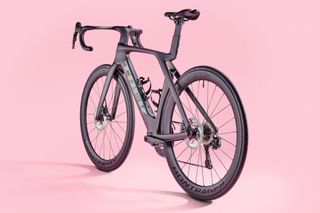
And by radically reengineering the frame Trek claims to have saved 300g, and says the new bike is almost 20 watts faster than its predecessor, which equates to 60 seconds per hour when ridden at 45kph. It looks radical, too - always a good thing for a new bike.
In our 2023 Race Bike of the Year grouptest we awarded the Madone 'best aero bike' against competition that included the Cervélo S5, the Canyon Aeroad and the Giant Propel.
However, over $9K / £10K for an Ultegra bike has to be unchartered territory - so how does it compare overall to the best road bikes ?
Trek Madone 7 Gen 7: construction

Let’s peer a bit more closely into that hole or, to give it its real name, IsoFlow. The aerodynamic explanation for it is: “It’s a way to direct some high energy flow into a low energy region of the bike.” What that means is that the seat tube area creates a disproportionate amount of drag and the hole helps to dissipate this by adding what Trek calls a “jet of fast moving air.”
It turns out that only half of the claimed watt saving comes from the IsoFlow hole. Trek has entered the integrated cockpit wars (along with Colnago, Canyon, Cervélo et al) with a completely new and very slick-looking design but it’s neither adjustable nor V-shaped: according to Trek it saves watts by changing rider position rather than via the aerodynamic properties of the cockpit itself.
A standard 42cm bar becomes 39cm at the hoods and 42cm at the drops and there’s a backsweep so that a flat-forearms aero position on the hoods becomes very aero indeed.
There are 14 different combinations available and, since the backsweep gives the bar a shorter reach, it’s important to get the right one - if you’re like those of us who rode this bike, you’ll need a longer stem. You can change this at point of purchase at no extra cost, Trek told us, or the 1 1/8in steerer is compatible with a non-integrated stem and bar (though the frame is electronic groupset only).
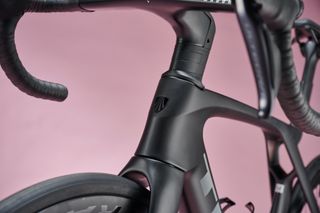
The same goes for the seatmast. The cutout in the seat tube leaves less room for a long seatpost and less adjustability (around 6cm minimum to maximum) so if you are long-legged but prefer a smaller frame you may need the tall version that comes with the size 56 upwards (as I ideally would have done). There are also two offsets available.
Our size 54 with a standard short mast could only manage a maximum saddle height of 74cm and the reach felt very short with the 90mm stem cockpit it comes with.
The latest geometry is called H1.5 (halfway between the old H1 race and H2 endurance). The reduced reach combined with the shorter reach of the swept-back bar works very well for that super aero hoods position, but it does feel surprisingly short. The kamm-tailed rear of the stem is much closer to your knees than you’d expect.
The new SLR bikes are all made from Trek’s 800 OCLV carbon - from the 105-equipped SLR 6 up to the flagship SLR 9 - and are impressively light, especially compared with other aero bikes such as the Cervelo S5. Trek says this is its lightest ever disc Madone.
There’s clearance for 28mm tires max, which is tight by modern standards. This model comes with Bontrager Aeolus Pro 51 tubeless-ready wheels, set up with Bontrager R3 Hard-Case Lite 25mm tires and inner tubes - again, surprisingly narrow.
Despite the fact that the fit wasn’t optimal - I could have done with the size up - the ride quality of the Madone is absolutely incredible. That’s the first thing that strikes you, or rather doesn’t strike you.
Aero bikes used to supply a harsher ride simply because deep, bladed tubing doesn’t flex like round tubing. This was undoubtedly the reason why Trek bolted the IsoSpeed decoupler onto the Madone two iterations ago. So you might expect that with its suspension system gone, the latest bike might have gone backwards in comfort. Not a bit of it.
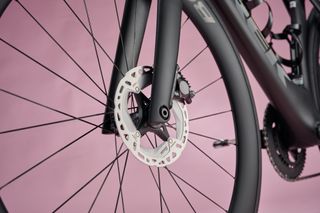
It feels like a coiled carbon spring - full of potential energy and floating over bad road surfaces seemingly without any effect on its speed. And this is on 25mm tires that aren’t even the best (at this price they really ought to be).
The handling is also exactly right. The shortish 90mm stem section of the cockpit could have made it a little twitchy, but thanks to the sweeping shape I found my weight sufficiently over the front wheel in the hoods position, and steering was fast but balanced on descents and tight corners.
So it passes ‘comfortable’ and ‘fast’ with flying colors (actually Deep Smoke for this one).
At 7.5kg it’s light for an aero bike - or any disc brake bike - and it leaps up hills as if it weighs even less. I was so impressed with its performance that I kept forgetting Trek also has the Emonda climbing bike. The next Emonda has its work cut out (pun intended).
Finally, stability in crosswinds. There’s one particular gateway on my test loop where any bike not designed for big yaw angles will be gusted and the Trek was indeed blown sideways slightly - but not alarmingly considering the deep wheels and frame tubes.
This bike is incredibly good but it’s also incredibly expensive. It’s a full $1,000 / £1,000 more than the equivalent outgoing Gen 6 Madone SLR 7, and you’d have to look hard to find a more expensive Ultegra Di2-equipped bike from the other mainstream brands.
The Canyon Aeroad CFR with Dura-Ace costs $8,999 / £8,799, while the Cervelo S5 with SRAM Force AXS costs $9,000 / £9,200. The Giant Propel Advanced SL1 also with SRAM Force costs $8,000 / £8,999.
You might also reasonably expect a power meter at this price - those three bikes all come with them - but it’s just the regular Ultegra crankset here.
So the price is stratospheric but compared with the current aero bikes I’ve ridden so far including the Colnago V4RS , Canyon Aeroad SLX , Cervelo S5, Tarmac SL7 and Pinarello Dogma F, the ride quality is superior.
- Frame: 800 Series OCLV carbon
- Fork: KVF carbon, tapered steerer
- Groupset: Shimano Ultegra Di2
- Wheels : Bontrager Aeolus Pro 51
- Tires : Bontrager R3 Hard-Case Lite 25mm
- Cockpit: Madone integrated
- Seatpost : Madone aero internal
- Saddle: Bontrager Aeolus Elite
- Weight: 7.5kg
- Contact: www.trekbikes.com
Thank you for reading 20 articles this month* Join now for unlimited access
Enjoy your first month for just £1 / $1 / €1
*Read 5 free articles per month without a subscription
Join now for unlimited access
Try first month for just £1 / $1 / €1
Get The Leadout Newsletter
The latest race content, interviews, features, reviews and expert buying guides, direct to your inbox!
Simon Smythe is a hugely experienced cycling tech writer, who has been writing for Cycling Weekly since 2003. Until recently he was our senior tech writer. In his cycling career Simon has mostly focused on time trialling with a national medal, a few open wins and his club's 30-mile record in his palmares. These days he spends most of his time testing road bikes, or on a tandem doing the school run with his younger son.

The Slovenian seals the overall victory at the Giro d’Italia with an emphatic win on the penultimate stage after a decisive attack on the Monte Grappa
By Joseph Lycett Published 25 May 24
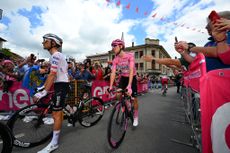
Can Tadej Pogačar take his sixth stage win of the race?
By Joseph Lycett Last updated 25 May 24
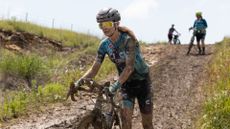
In a race with legendary tough conditions, Unbound veterans share the gnarliest editions of years past as we look ahead to what 2024 may bring.
By Logan Jones-Wilkins Published 24 May 24
Useful links
- Tour de France
- Giro d'Italia
- Vuelta a España
Buyer's Guides
- Best road bikes
- Best gravel bikes
- Best smart turbo trainers
- Best cycling computers
- Editor's Choice
- Bike Reviews
- Component Reviews
- Clothing Reviews
- Contact Future's experts
- Terms and conditions
- Privacy policy
- Cookies policy
- Advertise with us
Cycling Weekly is part of Future plc, an international media group and leading digital publisher. Visit our corporate site . © Future Publishing Limited Quay House, The Ambury, Bath BA1 1UA. All rights reserved. England and Wales company registration number 2008885.
- MAGAZINE OFFERS
- BIKE INSURANCE
- Best Products
- Maintenance
- Accessories
- Long-Term Reviews
- BikeRadar Podcast
- First Look Friday
- Bike of the Week
- Tech Features
- Routes and Rides
- Bike Galleries
- BikeRadar Bargains
- Buyer's Guides
- Fitness & Training
- Sizing & Fit
- Mountain Biking UK
- Cycling Plus
- Bike of the Year 2024

Trek Madone SLR 7 Gen 7 review
Goodbye IsoSpeed, hello IsoFlow
Simon von Bromley
Composed yet fast; innovative design; front end can run both integrated and non-integrated handlebar setups; wide range of frame sizes
Expensive; no power meter; mid-range tyres and cheap inner tubes don’t belong on this bike
Now in its seventh generation, the latest Trek Madone SLR is claimed to be both faster and lighter than ever.
Yet while this latest version retains a typically Madone-esque silhouette, it’s impossible to miss the bike’s unique selling point – the big hole in the seat tube, or IsoFlow, as Trek calls it.
IsoFlow might seem like the main story here, but it isn’t the only thing worth paying attention to.
Overall, the Trek Madone SLR 7 builds on the highly refined Madone platform.
Trek has brought the bike up to date and taken into account the latest aero trends. That's one of the reasons it earns a place in our 2023 Aero Road Bike of the Year category.
While the results are thoroughly impressive on the road, there's no ignoring the high cost of entry, especially on a build with some nominally mid-range parts.
Trek Madone SLR 7 Gen 7 frameset
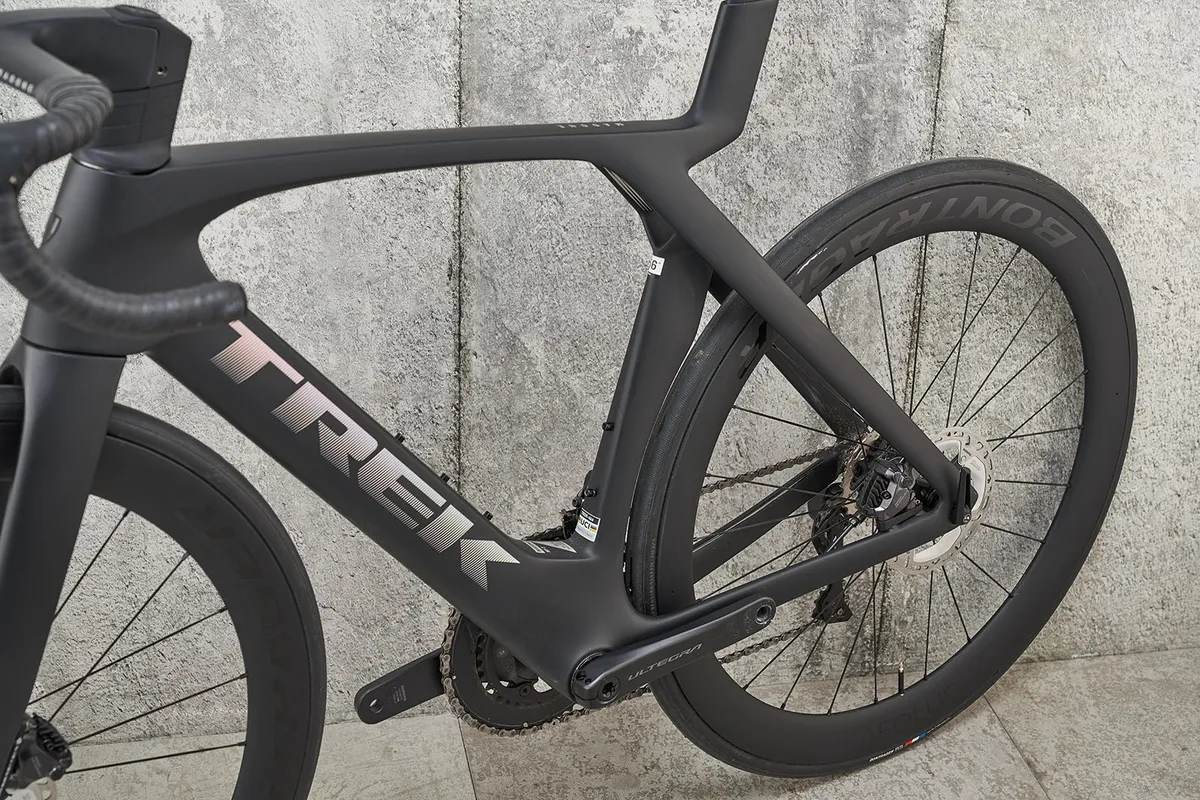
Unsurprisingly, pro-rider feedback about the previous Madone SLR was simply that those who rode it wanted the new one to be “faster and lighter”.
Starting with the subtler changes, Trek has updated its signature Kammtail Virtual Foil tube shapes (or truncated aerofoils, as everyone else calls them) and overhauled the front end, adding a lighter, fully integrated aero cockpit with flared drops.
Trek also says the handlebar’s narrow hood position plays a significant role in making the bike and rider more aerodynamic.
More noticeably, though, Trek has replaced the comfort-enhancing IsoSpeed system at the junction of the seat tube and top tube with a kite-shaped hole it calls ‘IsoFlow’.
Given most riders, pro or otherwise, apparently didn’t make frequent use of IsoSpeed’s adjustability, Trek opted to replace it with a simpler and lighter solution.
According to Trek, IsoFlow is both lighter and more aerodynamic than IsoSpeed.
Rear-end compliance is claimed to hit the same level as before (with the adjustable IsoSpeed set to its stiffest setting), because the seatpost is essentially cantilevered over the rear of the bike.
Overall, IsoFlow is a win-win solution, Trek says.

The sum of these changes is a bike that’s claimed to be 300g lighter for a complete bike. It’s not a night-and-day difference, but a nice saving nonetheless.
My size-56cm Madone SLR 7 weighs 7.69kg. While that’s slightly lighter than some similarly specced competitors, such as the Giant Propel Advanced Pro 0 AXS and Cervélo S5 , there are lighter aero bikes available for similar money.
The top-spec Canyon Aeroad CFR we tested in 2020, for example, weighed just 7.3kg (size medium). At the time of writing, the 2023 version costs £8,799, yet is specced with a Dura-Ace Di2 R9200 groupset.
In terms of speed, the new Madone is claimed to be 19 watts more aerodynamically efficient at 45kph than the previous one, with a rider on board.
This, Trek says, translates to a time saving of around “60 seconds per hour”, meaning a ride that would take an hour on the old Madone should only take 59 minutes on the new one. That’s an impressive saving for a racer, if the claims are to be believed.
Trek Madone SLR 7 Gen 7 geometry
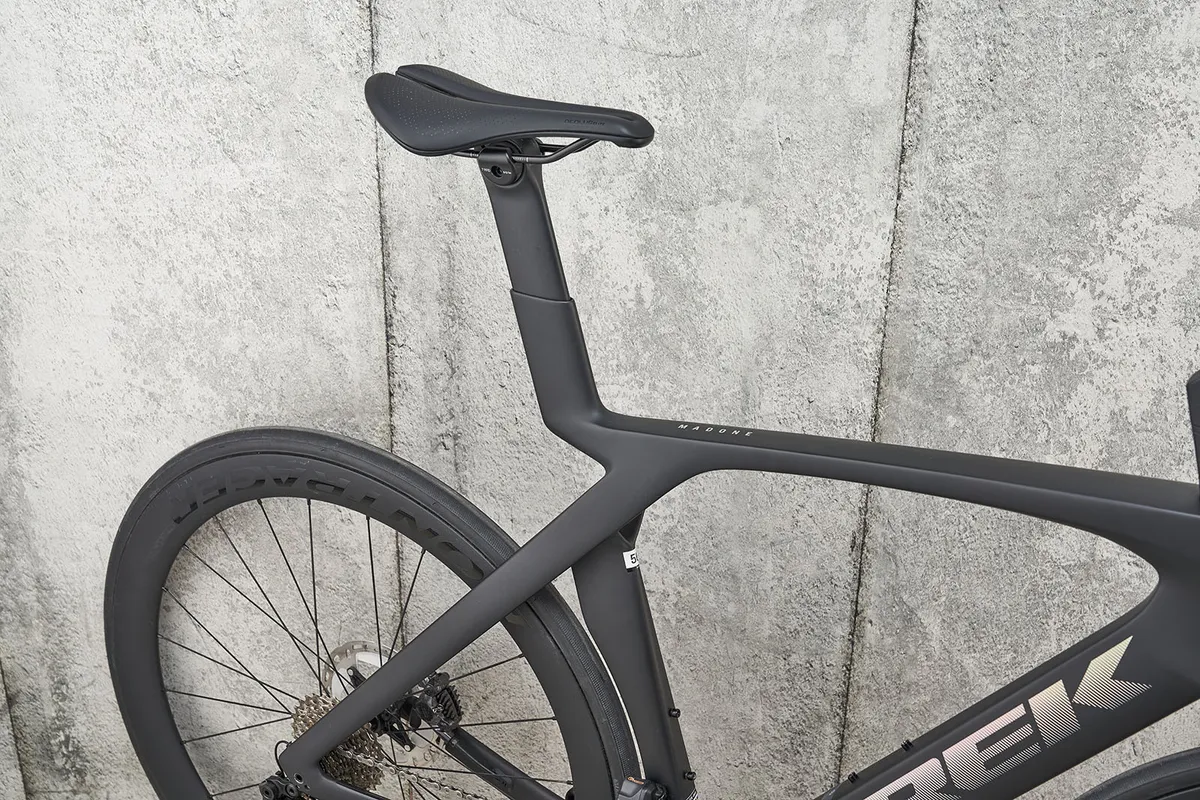
In terms of fit, the Madone SLR uses Trek’s H1.5 geometry (as seen on the latest Emonda SLR ) – a halfway house between the aggressive H1 and more relaxed H2 geometries it offered previously.
Helpfully, there are eight frame sizes in total, from 49cm to 62cm, meaning a wide range of riders should be able to find a well-fitting bike, too.
Overall, though, the measurements and angles are still very race-focused.
Stack and reach sit at 563 and 391mm respectively, almost identical to key competitors such as the latest Giant Propel and the Cervélo S5.
The head tube and seat tube angles (on my size-56cm test bike) are both relatively steep, at 73.5 and 73.3 degrees, respectively. It also has a short, 58mm trail and a tight wheelbase of just 983mm.
All of which points towards nimble, reactive handling and a riding position designed to encourage you into an aerodynamic riding position .
Trek Madone SLR 7 Gen 7 build
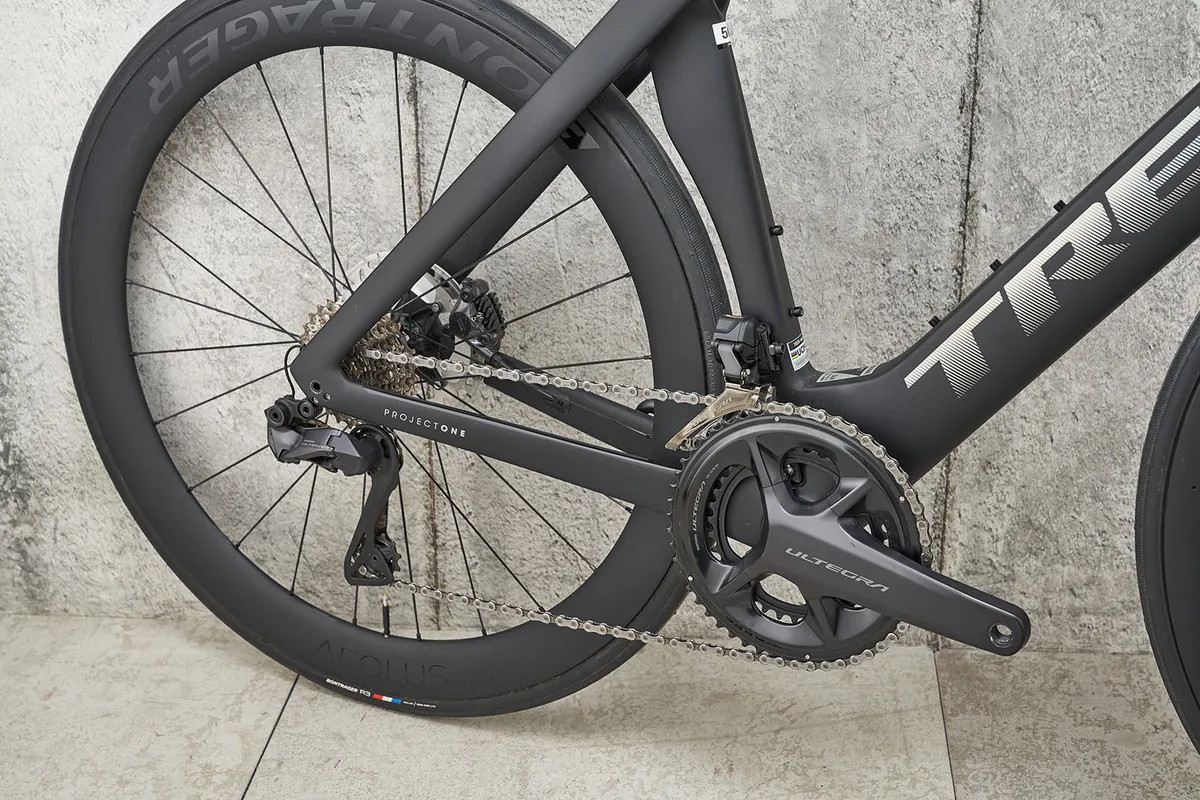
Despite the five-figure price tag, the build encompasses a suite of parts that are nominally mid-range (or would have been before the great bike industry price hikes of recent years).
You get Shimano’s Ultegra Di2 8100 groupset, instead of Dura-Ace Di2, for example. The wheelset is the mid-range carbon Bontrager Aeolus Pro 51, instead of the top-tier Aeolus RSL.
Trek has specced Bontrager R3 Hard-Case Lite clincher tyres (in a size 700x25c), instead of the pricier tubeless-ready versions or the beautiful (and even more expensive) R4 320 Handmade cotton clinchers.
A Bontrager Aeolus Elite saddle, with ‘Austenite’ (a type of steel alloyed with nickel) rails is chosen, rather than the Pro or RSL models with carbon rails.

You don’t get a power meter with Shimano builds, either. SRAM builds come with Quarq power meters as standard, though are a little more expensive as a result.
This ‘mid-range’ kit mostly performs excellently, though, and one could argue upgrading these parts to the fancier, lighter versions is only going to offer marginal gains at even greater expense (that’s what the £13,500 Madone SLR 9 offers).
However, when you consider some of the best aero bikes are available with equivalent specs for significantly less money, it’s a tough pill to swallow.
Still, Trek is far from the only brand making expensive bikes these days.
Whether it’s the Specialized S-Works Tarmac SL7 , Pinarello Dogma F or Colnago V4Rs , to name three, there are certain bikes that aren’t focused on value first and foremost, and that’s okay.
Though an important factor in any purchasing decision, value won’t be the only consideration for everyone, after all.
Trek isn’t cutting any corners with the most important aspect of the bike, either – the SLR frameset and integrated handlebar are exactly the same as those used to compete at the highest level.
Like my colleague, Ashley Quinlan , who reviewed the Madone SLR 9 eTap last year, I came away impressed by the Madone’s front-end.
As already noted, the new handlebar features a slightly narrower, 39cm (centre to centre) hoods position, while it flares out to 42cm wide at the drops.
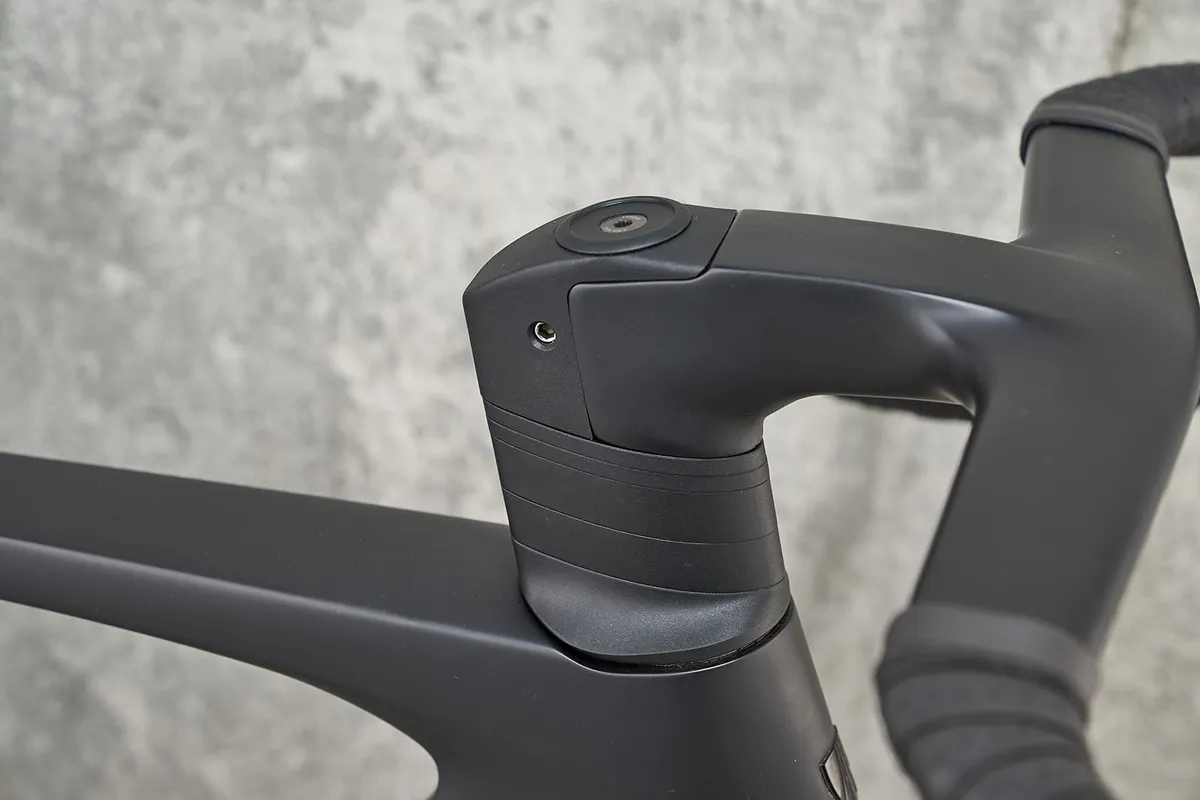
This gives you the aerodynamic gain of a narrower handlebar at the hoods, with the wider drops providing additional control and leverage for descending and sprinting.
It’s nowhere near as extreme as the 33/37cm handlebar featured on the Ribble Ultra SL R I tested just prior to the Madone, which inevitably means the gain isn’t as obvious. However, it’s certainly a less intimidating change for those not used to riding with narrow handlebars .
All things considered, it’s a positive change, with no notable compromises to comfort or handling.
There are 11 different stem-length and handlebar-width combinations available, and Trek says a dealer can swap a handlebar size at the point of purchase for no extra cost.
Alternatively, it’s also possible to run a standard, 1 1/8in stem and any handlebar you like, giving you near-limitless options for front-end customisation.
My only real disappointment was my test bike’s drab matt black paintjob .
Trek is renowned for producing some of the peloton’s best paintjobs in recent years, yet, save for the cool reflective down tube logo, this one is about as dull as they come.
Of course, others might feel differently and, either way, there are other choices available, plus the option for a custom paintjob through Trek’s Project One programme (at additional expense).
Trek Madone SLR 7 Gen 7 ride impressions
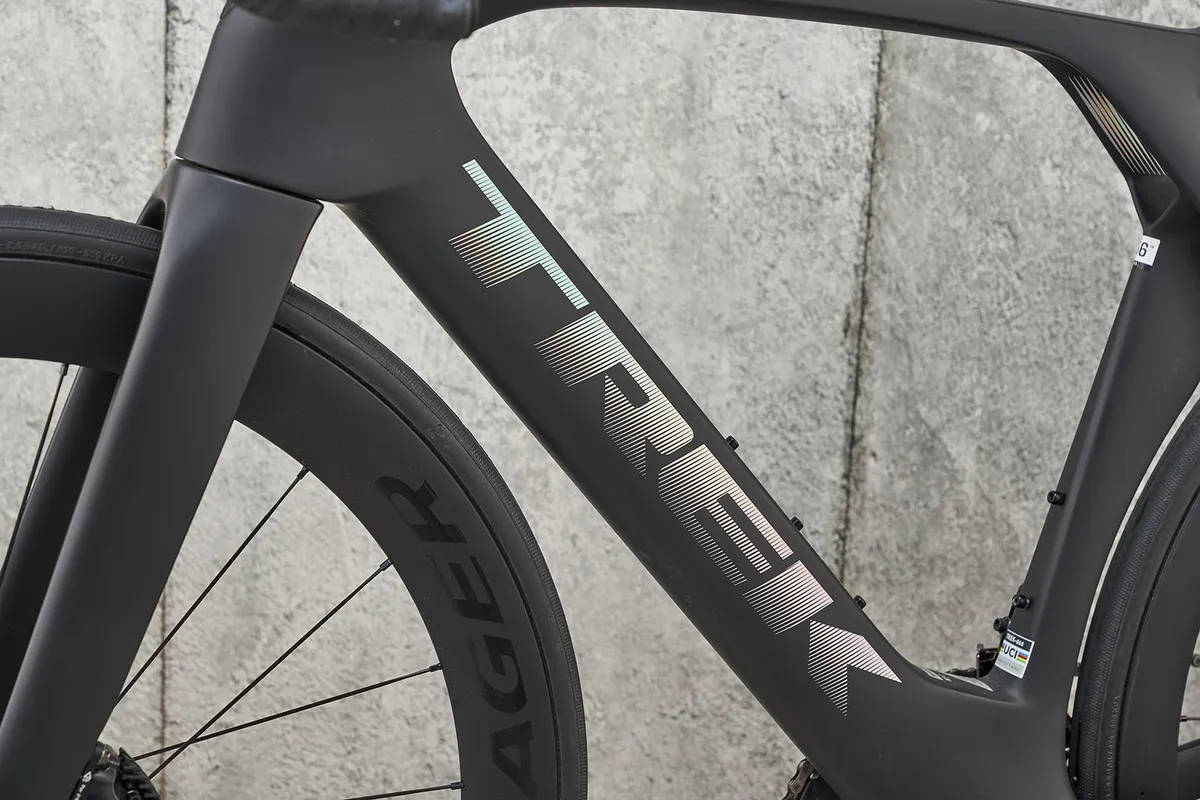
The Madone’s greatest strength is that it manages to feel like a non-aero bike, but faster.
It barrels along on flat or rolling roads, yet feels snappy and energising when you start climbing or rise out of the saddle to sprint over a brow.
I can’t say whether IsoFlow makes the Madone any faster, but it certainly makes for a comfortable rear end when paired with the excellent Bontrager Aeolus saddle (a firm favourite among many testers at BikeRadar).
It's obvious enough to make the handlebar feel fairly stiff in contrast, in fact.
As expected, Shimano’s latest Ultegra Di2 groupset (here with suitably sporty, 52/36-tooth chainrings and an 11-30-tooth cassette) offers near-faultless performance, albeit at a slightly heavier overall weight than Dura-Ace.
The latest Shimano hydraulic brakes, with burly 160mm rotors front and rear, make the Madone a great partner on descents, too.

Despite the quick handling and short wheelbase, there’s no hint of instability at high speeds.
The Bontrager Aeolus Pro 51 wheels also impress. At a claimed 1,590g for the pair, they don’t feel cumbersome when climbing steep pitches, yet the 51mm-deep rims provide a noticeable performance benefit on the flats.
A 23mm internal rim width also helps provoke extra volume out of the 25c tyres, which inflate to 28.5mm wide at 65psi/4.5 bar.
With an external rim width of 30mm, Trek likely opted for 25c tyres (rather than 28c or larger tyres as many brands now do) to optimise the aerodynamic performance of the combination.
On good-quality roads, this combination doesn’t pose any issues, but I did find myself wanting for greater tyre volume whenever my test rides took a turn down a broken lane.
Fortunately, there’s plenty of scope to size up, if you want more cushioning or grip.
Frame and fork clearance is rated for up to 28c tyres (which would likely measure around 30mm wide on the Bontrager rims), but the space around both front and rear tyres suggests that’s a conservative estimate.
My main issue in this area, though, is the stock Bontrager tyres offer only average performance.

Grip levels are good, but rolling speed isn’t competitive with the best road bike tyres , and the ride feel is disappointingly wooden too.
The latter two points can be attributed partly to the basic butyl inner tubes supplied as stock.
Upgrading to latex or TPU inner tubes would doubtless go some way to improving both, but it’s also fair to say these tyres won’t ever get the most out of this bike no matter what you put in them.
That Trek is charging £10,200, yet skimping on something as critical as tyres, is disappointing.
Replacing them would be relatively easy and inexpensive, of course (and you could go tubeless too, with the addition of tubeless rim tape, valves and sealant for the wheels), but you shouldn’t have to when you’ve spent this much money.
Trek Madone SLR 7 Gen 7 bottom line
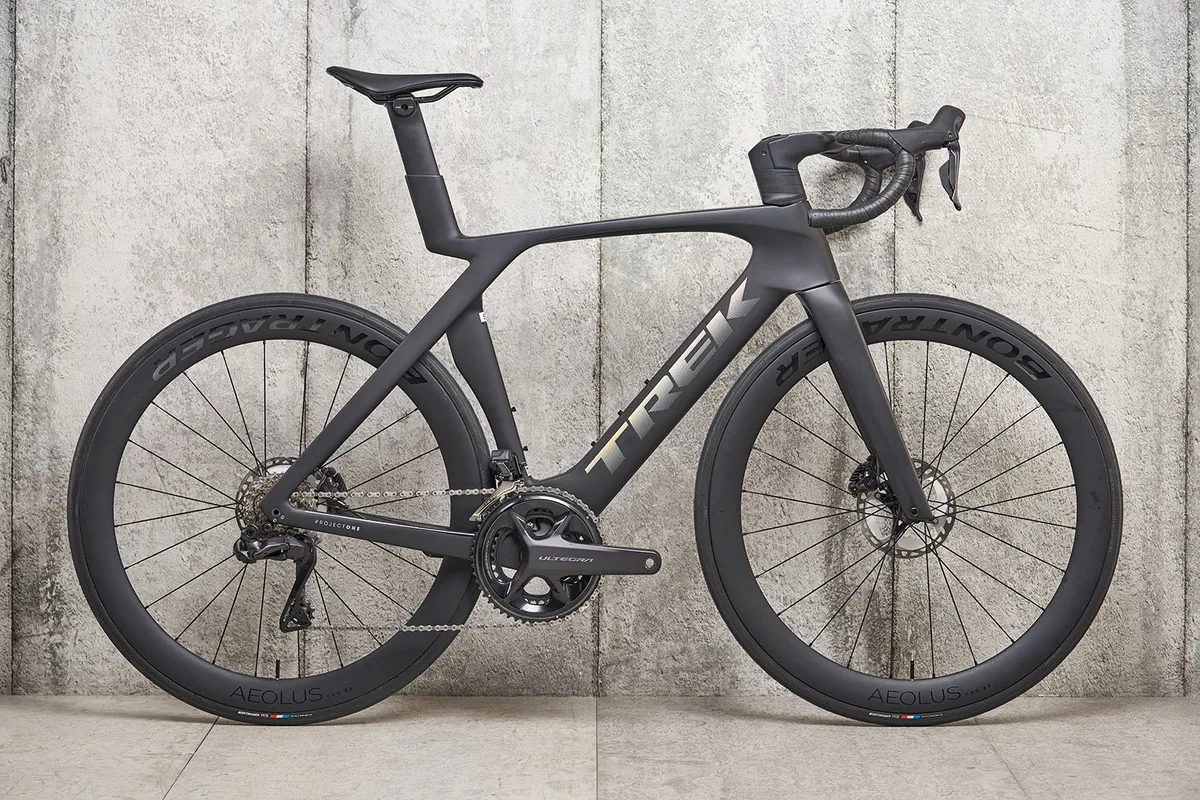
The Trek Madone SLR 7 manages to combine the fun and engaging ride quality of a normal race bike with the speed of an aero bike.
It would be a fantastic companion for racing or fast group rides, yet is comfortable enough for big days in the saddle, too.
Though technically mid-range, the parts and components offer excellent all-round performance (tyres and inner tubes aside). Even so, it’s still hard to ignore the fact there are many similarly specced competitors available that cost far less.
However, if you want a super-fast road bike that pushes the boundaries of aerodynamic design and says ‘Trek’ on the down tube, the Madone SLR doesn’t disappoint.
Aero Road Bike of the Year 2023 | How we tested
If you’re trying to ride faster, then aerodynamic drag is usually your biggest problem.
Previously, though, picking a dedicated aero road bike meant compromising on things such as comfort and practicality. Fortunately, such issues are (largely) problems of the past.
Today’s aero bikes are fast on the flats and no slouches up hills either. Most now include clearance for wide tyres and the best have front ends that don’t require a degree in mechanical engineering to work on.
With that in mind, we put the contenders to the test on the twisty, technical and rolling hills of south Bristol.
As with all road bikes, we considered how easy each bike is to live with, and how easily the stock setup can be adjusted to suit your personal needs and riding style.
Many of the bikes featured in this year’s Aero Road Bike of the Year test are at the upper end of the pricing scale, with premium groupsets and parts showcasing the best contemporary equipment. However, most are also available in cheaper specs if your budget doesn’t stretch as far.
Our Aero Road Bike of the Year contenders
- 3T Strada ICR Force eTap AXS
- Giant Propel Advanced Pro 0 AXS
- Ribble Ultra SL R Enthusiast
- Trek Madone SLR 7
Thanks to our sponsors, Lazer , FACOM tools and Band Of Climbers for their support in making Bike of the Year happen.
Share this article

Senior technical writer

- Terms & Conditions
- Subscribe to our magazines
- Manage preferences
Online Returns Policy
FAST SHIPPING
- Urgent Question? WhatsApp us now!
- Click & Collect in 48 hours
- Interest Free Finance

TREK Madone SL 7 Gen 7 Road Bike in Plasma Grey
With Pre-Order , you can purchase the latest items added to our store in advance of them arriving with us.
Your Pre-Order is prioritised (at no additional charge); meaning that as soon as the product arrives with us, we can wrap it straight back up; ready for collection via Click & Collect or despatch to you — it often never even hits the stock room shelves!
With Pre-Launch , the date when we expect to receive the product ourselves is still a little too hazy to be confident in accepting Pre-Orders.
So, instead, you can submit your email address against the item you are interested in and we will email you as soon as stock arrives on the system.
Estimated Delivery & Collection Dates are given on Pre-Order and Pre-Launch products. They are for indication purposes only and can change at any time without notice.
The dates we provide are based on indications given by our suppliers. Whenever we get updated information from our suppliers we will endeavour to update the Estimated Delivery & Collection Dates provided on product pages.
If you are not happy with any items purchased via our website, under Consumer Contracts Regulations you have the right to return any unused products for a refund or exchange within 30 days.
When the customer sends an item back to the company (or, when the company arranges for collecting from the customer), the company will process the returned item then notify the customer via email of the refund. The refund will be issued within 3 - 5 working days of the product being received by us, it may then take an additional 3 - 5 working days for the refund to be paid into the customers account.
For items returned within the cooling off period...
- By law, customers have the right to withdraw from the purchase of an item within 14 working days of the date on which the item is delivered.
- Where you are withdrawing from your purchase within the cooling-off period, and there has been no error on our part, we will refund the cost of the item.
- The company will not refund the cost of delivery or other services provided to the customer in connection with the purchase.
- The cost of delivery back to the company is the responsibility of the customer.
- Where we collect an item from you, we reserve the right to recover the costs of collection from you.
TERMS AND CONDITIONS
- Returned goods should be unused, in a saleable condition and in their original packaging with all labels still attached. Team Cycles is entitled to refuse the return or deduct from a refund as a result of the product not being in the above condition.
- We are only able to exchange like for like products. If you require a different item, you will need to opt for a refund and place a new order. All returns must have a completed returns form.
- We will refund you to your original payment method.
- We make no charge for returns, there is no restocking fee.
- Customised items cannot be returned. *
- Please do not send your purchase back to the manufacturer unless you have been advised to.
- Team Cycles customers have 30 days from date of delivery to return their orders.
- Once we have received the returned goods we will refund you, by the method you used to pay for your order. This may take 5-7 working days to appear as cleared funds.
*Faulty customised goods (or goods that have been altered in any way) will need to be returned for inspection as customisation may void your warranty and therefore faults may not be covered.
All products ordered from Team Cycles come with a full warranty which covers manufacturing faults and defects in workmanship. If you feel that your purchase has developed a fault, please contact our store for an assessment. To do this you will need proof of purchase.
If taking your product in store is not an option then please email our team on [email protected] . Please include photographs of your product (please keep below 20mb), your web order number (or copy of receipt) so we can immediately start to assess the issue.
PLEASE NOTE:
In some cases, the manufacturer/supplier may require to see the item(s) before repair or replacement can take place. If this is the case, we will inform you and arrange how to do this. All used items being returned to us must be cleaned for hygiene purposes.
On receipt of your goods we will carry out a full inspection and contact you within three working days of receipt.
Team Cycles (North East) Limited acts as a broker and not the lender and offers finance from Secure Trust Bank PLC T/A V12 Retail Finance. Team Cycles (North East) Limited is authorised and regulated by the Financial Conduct Authority, Registration Number 623982. Not all products offered by Secure Trust Bank T/A V12 Retail Finance are regulated by the FCA. Subject to age, status and affordability, minimum spend applies.
Season:2024
Code:41467GRY
It's right for you if...
You want speed, quality and performance with a carbon frame that turns heads, a premium electronic drivetrain, long-lasting tyres that corner fast and grip hard, revolutionary IsoFlow aerodynamics and an all-out aero road rig that makes every ride feel like your fastest ride ever.
The tech you get
A 500 Series OCLV Carbon frame with aero Kammtail tube shaping and revolutionary IsoFlow seat tube, invisibly routed cabling, a super fast Shimano Ultegra Di2 12-speed electronic drivetrain, Bontrager RSL Aero OCLV Carbon handlebars and Bontrager Aeolus Pro 51 tubeless-ready carbon wheels.
The final word
The Madone SL 7 is a premium race-ready speed demon that's itching to take you on your fastest road rides and carry you to the podium on every race. It belongs at the front of the group setting the pace and conquering KOMs.
Frame 500 Series OCLV Carbon, KVF (Kammtail Virtual Foil) tube shape, IsoFlow seat tube, invisible cable routing, 3S aero chain keeper, T47 BB, flat-mount disc, 142x12mm thru axle
Fork Madone KVF full carbon, tapered carbon steerer, internal brake routing, flat mount disc, carbon dropouts, 12x100mm thru axle
Wheel front Bontrager Aeolus Pro 51, OCLV Carbon, Tubeless Ready, 100x12mm thru axle
Wheel rear Bontrager Aeolus Pro 51, Tubeless Ready, Shimano 11/12-speed freehub, 142x12 mm thru-axle
Skewer front Bontrager Switch thru-axle, removable lever
Skewer rear Bontrager Switch thru-axle, removable lever
Tyre Bontrager R3 Hard-Case Lite, aramid bead, 120 tpi, 700x25 mm
Max tyre size 32mm (as measured, see manual for details)
Shifter Shimano Ultegra R8170 Di2, 12-speed
Front derailleur Shimano Ultegra R8150 Di2, braze-on, down swing
Rear derailleur Shimano Ultegra R8150 Di2, 34T max cog
Crank Size:47 Shimano Ultegra R8100, 52/36, 165 mm length
Size:50, 52 Shimano Ultegra R8100, 52/36, 170 mm length
Size:54, 56 Shimano Ultegra R8100, 52/36, 172.5 mm length
Size:58, 60, 62 Shimano Ultegra R8100, 52/36, 175 mm length
Bottom bracket Praxis, T47 threaded, internal bearing
Cassette Shimano Ultegra R8100, 11-30, 12 speed
Chain Shimano XT M8100, 12-speed
Max. chainring size 1x: 50T, 2x: 54/40
Saddle Size:47, 50, 52 Bontrager Aeolus P2 Comp, 155mm width
Size:54, 56, 58, 60, 62 Bontrager Aeolus Comp, steel rails, 145 mm width
Seatpost Madone aero carbon seatpost, integrated light mount, 0mm offset, long length
Handlebar Size:47 Bontrager RSL Aero, OCLV Carbon, 31.8 mm, Di2 routing, 80 mm reach, 124 mm drop, 35 cm control width, 38 cm drops width
Size:50, 52 Bontrager RSL Aero, OCLV Carbon, 31.8 mm, Di2 routing, 80 mm reach, 124 mm drop, 37 cm control width, 40 cm drops width
Size:54, 56 Bontrager RSL Aero, OCLV Carbon, 31.8 mm, Di2 routing, 80 mm reach, 124 mm drop, 42 cm width
Size:58, 60, 62 Bontrager RSL Aero, OCLV Carbon, 31.8 mm, Di2 routing, 80 mm reach, 124 mm drop, 41 cm control width, 44 cm drops width
Handlebar tape Bontrager Supertack Perf tape
Stem Size:47 Trek RCS Pro, -7-degree, 70 mm length
Size:50 Trek RCS Pro, -7-degree, 80 mm length
Size:52, 54 Trek RCS Pro, -7-degree, 90 mm length
Size:56, 58 Trek RCS Pro, -7-degree, 100 mm length
Size:60, 62 Trek RCS Pro, -7-degree, 110 mm length
Brake rotor Shimano CL800, CentreLock, 160 mm
Rotor size Max brake rotor sizes: 160 mm front and rear
Charger Charging cable included
Weight 56 - 8.00 kg/17.64 lb
Weight limit This bike has a maximum total weight limit (combined weight of bicycle, rider and cargo) of 125 kg (275 lb).
Ask a question
You may also like....
- £6699.00 £8300.00 TREK Emonda SLR 7 Road Bike in Dark Prismatic and Black
- £5499.00 £8000.00 TREK Emonda SLR 7 AXS Road Bike in Navy Carbon Smoke and Blue
- £4900.00 £5550.00 TREK Emonda SL 7 Road Bike in Trek White and Quicksilver
- £4900.00 £5580.00 TREK Emonda SL 7 Road Bike in Mulsanne Blue and Trek Black
- £2099.00 £2700.00 TREK Emonda SL 5 Disc Road Bike in Carbon Blue Smoke and Blue
Finance your purchase

Consumer credit services are only available to over 18s and subject to status.
Credit is provided by V12 Retail Finance Ltd, a trading name of Secure Trust Bank Plc. which is registered in England and Wales: 541132. Registered Office: Yorke House, Arleston Way, Solihull, B90 4LH. Secure Trust Bank Plc is authorised by the Prudential Regulation Authority and regulated by the Financial Conduct Authority and the Prudential Regulation Authority with registration number 204550. For more information please visit www.v12retailfinance.com .
If you are intending to use finance as your payment option, please note we will only ship your order to your billing address, and not to an alternative delivery address.
This is for estimation purposes only. Actual finance application is completed during checkout.
Important Links
Useful links, customer support, opening times, got an urgent question whatsapp us.

Subscribe to my YouTube channel for video reviews.
Trek Madone Bikes Compared: Which One to Choose?
CyclistsHub is supported by its readers. We may receive a commission if you buy products using our links.
In this article, I’ll help you navigate the Trek Madone aero road bikes by comparing the Madone SL 6 to SLR 9 .
You will also learn:
- Who are they best suited for?
- About the differences between each model and Gen 6 vs. Gen 7.
- Why I think you shouldn’t buy Trek Madone with SRAM groupset.
Plus, I’ll tell you which model gives you the best value for your money to help make your decision easier.
KEY TAKEAWAY
Trek Madone bikes are ideal for flats and rolling terrains. They are the most aero bike family of all Trek road bikes . The models differ in components (e.g., electronic shifting or wheels) and frames. The more expensive ones are usually lighter and have a higher-grade carbon frame, but usually diminishing returns.
This article compares Trek Madone Gen 6 and 7. The main difference between Madone Gen 6 and Gen 7 is that Gen 6 has IsoSpeed decoupler, while Gen 7 has IsoFlow.
Trek Madone SL 6 vs. SL 7 vs. SLR 6 vs. SLR 7 vs. SLR 9
The following table summarizes the main differences between all Madone bikes.
Madone Pros & Cons Summary
I summarized the pros & cons of the Madone series below.
Madone Pros
- Faster than standard road bikes thanks to the aero frame
- Madone Gen 7 stands out from the crowd thanks to the IsoFlow
- Racing geometry
- Availability in multiple sizes and colors
- Integrated cable routing
- Lifetime warranty
Madone Cons
- Heavier than Émonda road bikes
- More expensive than non-aero road bikes
- No aluminum models are available
- Narrow tire clearance (28mm)
Madone Main Features
Let me now explain the most important features of the Trek Madone aero bikes.
Frame and Geometry
The Madone bikes are part of Trek’s road bike lineup . They’re made of carbon. No aluminum version of the Madone is available.

The names of the bikes have abbreviations that refer to the type of carbon used for the frame:
- SL are bikes with 500 series OCLV* carbon (mid-range).
- SLR are bikes with 800 series OCLV carbon (high-end).
*OCLV carbon is Trek’s patented carbon fiber process ( learn more ).
SL (Gen 6) frames are heavier than SLR (Gen 7), mainly due to the IsoSpeed vs. IsoFlow ( learn more ).
The bikes are available in many sizes (47-62) and colors. They have a relatively relaxed geometry compared to the Cervelo S5 but are almost identical to the Cannondale SystemSix.
Aerodynamics
Aerodynamics evaluation is a challenging discipline because it requires a lot of resources. No extensive independent database is available that compares the speed of different aero wheels.
In Trek’s whitepaper , I learned that the Madone Gen 7 is 19W faster than Gen 6 at 45 km/h.

However, it’s hard to compare it with other bikes. But it’s rumored that Madone is among the fastest aero bikes.
For instance, in Cannondale’s whitepaper , there’s a comparison of Cannondale SystemSix (one of the fastest aero bikes) with Madone 9.9. Madone was only slightly worse.
Wheels and Tires
On some Madone models, the wheels may be different, but typically, they come with Bontrager Aeolus Pro 51 wheels.
Surprisingly, the front and rear wheels have the same rim depth. Other aero bike manufacturers often use deeper wheels in the rear and shallower ones in the front.
The same goes for tires. Madones come with 25mm tires in both the front and rear, but it’s common for competitors’ bikes to have 25mm tires in the front and 28mm tires in the rear.
Remember, the wheels are tubeless-ready, but the tires are clinchers.
Unsurprisingly, the Madone bikes have a 2X drivetrain, as is customary for road bikes.
Trek fits them with Shimano and SRAM groupsets, and the number in the bike name indicates the groupset.
- Models ending with 6 use Shimano Ultegra , 105 Di2 (R7100) or SRAM Rival AXS groupsets.
- Models ending with 7 use Shimano Ultegra Di2 (R8100) or SRAM Force AXS groupsets.
- Models ending with 9 use Shimano Dura-Ace Di2 (R9200) or SRAM Red AXS groupsets.

Interestingly, the Madones with SRAM are heavier than the Madones of the same series with the Shimano groupset. In addition, the Shimano bikes are also cheaper.
This is somewhat strange because Shimano retail prices are higher than SRAM. That’s why I recommend choosing Trek bikes with Shimano groupsets unless you prefer SRAM.
IsoSpeed vs. IsoFlow
Undoubtedly, IsoSpeed and IsoFlow have become unique features that make Madone stand out from the crowd.
The IsoSpeed decoupler aimed to improve riding comfort by absorbing road vibrations. Unfortunately, it added weight to the bike.

The 7th generation Madone took people’s breath away. IsoFlow is a significant design change from the traditional bike appearance, but it’s supposed to improve both riding comfort and aerodynamics.
On the other hand, some have expressed opinions that the change in shape from a classic triangle to a quadrilateral will inherently reduce the overall frame stiffness. Learn more in the following video.

So, which Trek Madone bike is the best?
If you’re considering buying a Madone, I suggest going for a model with a Shimano groupset. They tend to be lighter and less expensive than the equivalent SRAM models.
Consider the Madone SL 6 or 7 (Gen 7) for the best value for money. You will get an adjustable cockpit (which you won’t get with SLR Gen 7), Gen 7 frame (IsoFlow), and Shimano 105 Di2 or Ultegra Di2.
The only sacrifices you make are the lower-grade carbon, higher weight, and slightly worse aerodynamics and aesthetics due to the semi-integrated cockpit.
Trek Madone FAQ
Trek Madone bikes are for pro cyclists, competitive roadies, and enthusiast cyclists who want a unique-looking but fast road bike. They are ideal for flats, rolling terrain, and fast-paced rides (races, criteriums, etc.).
The main differences between Madone Gen 6 and Gen 7 are that Gen 6 has IsoSpeed decoupler, while Gen 7 has IsoFlow. Gen 7 frames are lighter and 19W faster at 45km/h ( source ). They also look different due to the significant design change. Trek introduced SL 6 and SL 7 Gen 7 with an adjustable cockpit in August 2023. These bikes are more affordable than the SLX versions.
The main difference between Madone and Émonda is that Madone is a pure aero road bike, while Émonda is a lightweight road bike for climbing. For more detailed info, please check out my comparison of Madone vs. Émonda .
The main difference between Madone and Domane is that Madone is a pure aero road bike, while Domane is an endurance road bike with wider tire clearance, also suitable for off-road adventures. Learn more in my Madone vs. Domane comparison.
About The Author
Petr Minarik
Leave a comment cancel reply.
Your email address will not be published. Required fields are marked *
Save my name, email, and website in this browser for the next time I comment.
Start typing and press enter to search
- Madone SL 7 AXS Gen 6
- Go! E-bikes
- Accessories
- Find a retailer
ABOUT ELECTRA
- Electra history
- Flat Foot Technology
- Brand partners
- Electra Funbassadors
- Work at Electra
- Customer care
- Bike registration
- Manuals & user guides
- Shipping & delivery
- Newsletter signup
- Global distributors
- How to shop safely
- Privacy policy & terms of use
- Accessibility
- Cookie policy
- California Transparency Act
United States / English
- © Electra Bicycle Company 2024
Loved the world over, the Marlin has long held the hearts of new riders and seasoned rippers alike, and to keep everyone rolling with ear-to-ear grins we’ve revamped it with more trail confidence than ever. Whether zipping through town, dipping your toes into the trail for the first time or slicing through switchbacks as a well-seasoned rider, you’ll appreciate the sleek new frame that ups the capability and brings looks to match. There’s a reason why it’s always been your favourite.
Total trail confidence A bike's geometry is the defining framework it's built on, and the Marlin is a true mountain bike at it's core. Its measurements are perfectly dialled to give you a confidence-inspiring, planted feel when you’re rolling down steep and bumpy trails, while keeping it easy to pedal back to the top when you’re ready for another lap.
Marlin’s head tube (a) sits at a slacker (more acute) angle. The slacker head tube angle (b) moves your front wheel further in front of you. Take it to the trail, and this slacker head tube angle (b) boosts stability and control for confidence when descents get steep and rowdy.
To balance a slacker head tube angle (b) , the Marlin features a steeper (more upright) seat tube angle (d) . A steeper seat tube (c) lets you get the most out of every pedal stroke, so you don’t waste power on the climb to the top.
The Marlin is equipped with a short stem and wider handlebar for more direct control and responsiveness when you’re manoeuvring through rocks and roots. Meanwhile, a longer reach (e) gives you extra stability so you can ride faster and more confidently.
Secure your ride
A new Thru-Skew axle provides better rear wheel security, holding your wheel in place snugly and ensuring it doesn't slip out of the frame, even when you're rolling through rough-and-tumble terrain.
Fully guarded
Full-length, full-coverage guards on the chainstay protect your frame and keep your ride quiet.
Float on the trail
Big 2.4˝ tyres elevate traction, so you stay planted on dusty switchbacks. But not only do bigger tyres give you more grip — they also soak up bumps for a smoother ride.
Upgrade ready
With a frame this nice, you won’t want to part ways with your Marlin as your skills grow. The Marlin Gen 3 is upgrade-ready, so you can upgrade your bike when you upgrade your skills. New internal cable routing lets you install a dropper post – and sizes XS and up can be upgraded to a bigger 120 mm fork when you’re ready to take on bigger trails.
A bike for everyone We believe that every rider deserves a well-fitted bike, that’s why the Marlin is available in every size from XXS to XXL – and even an 'extra-medium' size for riders who fall in between a medium and large. Each size is tuned to its riders, with Smart Wheel Sizing that scales the wheel size with the bike size, so every rider has comfortable standover height. Smaller, XXS and XS frames also feature a curved top tube to boost confidence and make getting on and off a breeze.
- Shop XS bikes
Make Marlin yours Whether you’re regularly ripping up the trail or a rugged city commuter, your Marlin can be fully customised with a treasure-trove of accessories. From kickstands and grips to bottle cages and bags, you can turn your Marlin into the perfect bike for your everyday ride.
- Deck out your Marlin
Trek warranty and backing We believe that when you put your heart and soul into something, you should have the stomach to back it up. That’s why we stand behind all Trek bikes with a limited-lifetime warranty. From your first ride to your 500th, we’ll be here for you in the unlikely event that something goes wrong with your Marlin. All you have to do is pop into your local Trek retailer and you’ll find all the support you need to get back spinning in no time.
The Marlin family Both generations of Marlins are true mountain bikes aimed at the rider who wants a versatile hardtail capable of off-road singletrack or in-city missions. Both generations have a 100 mm travel suspension fork and 29” wheels on most sizes except for smaller sizes with proportionate suspension travel and wheels, thus making it a great bike for shorter riders as well.
Marlin Gen 2
Get all-around versatility on Marlin Gen 2. It fits up to 2.2˝ tyres, and features balanced, neutral geometry that keeps you comfortable and in control as you venture off-road.
Marlin Gen 3
Get serious trail capability with Marlin Gen 3’s bigger, 2.4˝ tyre clearance, internal dropper post routing and a stiffer, more secure ThruSkew rear axle. Plus, its updated longer, slacker geometry gives you a boost in stability on steeper trails and at higher speeds.
Looking for something more to fill your singletrack appetite?
If you’re itching for a lighter weight, even faster hardtail, the X-Caliber is your ride. It’s light, sleek and efficient – perfect for new riders, cross-country racers and anyone who wants to cover a lot more trail miles in a lot less time.
The Roscoe delivers the capability of a full suspension trail bike in a simple hardtail package. The laid-back geometry that gives you tons of stability on rowdier trails, and it rolls on big 2.6˝ tyres that give tons of traction for getting through rough and tricky sections of trail.

IMAGES
VIDEO
COMMENTS
Madone SL 7 Gen 7. $6,499.99. Model 5298633. Retailer prices may vary depending on location and delivery method. The final price will be shown in your cart. Madone SL 7 Gen 7 offers legendary speed, cutting-edge tech, and unbelievable ride quality in a 500 Series OCLV Carbon package that keeps things light and quick for fast rides and races.
The differences are subtle, but the most impactful is the new Trek Madone SL Gen 7 uses Trek's 500 series OCLV carbon. Really, that means it is a slightly heavier composite that adds weight but also increases durability. The Trek PR for the new Gen 7 SL is claiming "nearly 300 grams lighter than the bike that came before it."
Otherwise, the differences between the Madone SL and Madone SLR simply boil down to more economical build kits. My Madone SL 7 test sample is the nicer of the two complete Madone SL bikes Trek offers currently, and comes equipped with a complete Shimano Ultegra Di2 2×12 wiredless electronic groupset, Bontrager Aeolus Pro 51 carbon fiber clincher wheels wrapped with 25 mm-wide Bontrager R3 ...
Weight: 17.6 lbs Frame: Carbon ... The Trek Madone SL Gen 7 now completes the line matching the more expensive SLR and offers almost the same ride quality. Read Review. Trek Madone SLR 7 Gen 7 review. May 2023 · Simon von Bromley. The seventh-generation Madone is an excellent all-round performer, but it comes with a big price tag ...
The new Trek Madone SL Gen 7 comes in two 12-speed Shimano builds: SL7 with Ultegra and SL 6 with 105. Though the groups and price structure change accordingly, a few specs remain the same throughout. SL 7 and 6 come with the cockpit, the new Bontrager RSL Aero-OCLV Carbon bar, and the RCS Pro - 7° stem. For tires, both roll on Bontrager R3 ...
Weight: 18.5 lbs Frame: Carbon ... The Trek Madone SL Gen 7 now completes the line matching the more expensive SLR and offers almost the same ride quality. Read Review. Trek Madone SLR 7 Gen 7 review. May 2023 · Simon von Bromley. The seventh-generation Madone is an excellent all-round performer, but it comes with a big price tag ...
Madone SL 7 Gen 6. 8 Reviews / Write a Review. $5,999.99 $6,999.99. Model 5277772. Retailer prices may vary. Madone SL 7 Disc combines advanced aerodynamic performance and all-around ride quality with the blazing fast, reliable shifting of Shimano's wireless Ultegra Di2 electronic drivetrain. It's light, fast, and incredibly sleek, and it comes ...
Weight: 7.5 kg Frame: Carbon ... The Trek Madone SL Gen 7 now completes the line matching the more expensive SLR and offers almost the same ride quality. Read Review. Trek Madone SLR 7 Gen 7 review. May 2023 · Simon von Bromley. The seventh-generation Madone is an excellent all-round performer, but it comes with a big price tag ...
The new Supersix was sold out till May 2024. Side note, the new SL is basically the same weight as the outgoing Gen 6 SLR of the same groupset. Not that the Gen 6 was very light, but this SL seems a very solid buy. 2024 Madone SLR 9 (w/ Ultegra) - 7.5kg. 2021 FUEL EX 9.9 AXS - Thicc.
It's a full $1,000 / £1,000 more than the equivalent outgoing Gen 6 Madone SLR 7, and you'd have to look hard to find a more expensive Ultegra Di2-equipped bike from the other mainstream ...
Trek Madone SLR 7 Gen 7 review - Road Bikes - Bikes - BikeRadar
Weight 56 - 8.00 kg/17.64 lb. Weight limit This bike has a maximum total weight limit (combined weight of bicycle, rider and cargo) of 125 kg (275 lb). ... Question(s) answered about TREK Madone SL 7 Gen 7 Road Bike in Plasma Grey . Ask a question. Question(s) asked regarding TREK Madone SL 7 Gen 7 Road Bike in Plasma Grey. Ask a question. Your ...
Model 587000. Retailer prices may vary. Madone SL 7 Disc combines advanced aerodynamic performance and all-around ride quality with the quick and reliable shifting of an electronic drivetrain. It's light, fast, and incredibly sleek, and it comes with aero carbon wheels, a road-smoothing IsoSpeed decoupler, and powerful hydraulic disc brakes ...
The main differences between Madone Gen 6 and Gen 7 are that Gen 6 has IsoSpeed decoupler, while Gen 7 has IsoFlow. Gen 7 frames are lighter and 19W faster at 45km/h ( source ). They also look different due to the significant design change. Trek introduced SL 6 and SL 7 Gen 7 with an adjustable cockpit in August 2023.
Be the first to write a review! $3,799.99. Model 5309910. Retailer prices may vary. Madone SL Disc Gen 7 Frameset offers legendary speed, cutting-edge tech, and unbelievable ride quality in a 500 Series OCLV Carbon package that keeps things light and quick for fast road rides and races. Plus, IsoFlow technology smooths out the bumps in the ...
Weight: 56 - 8.40 kg / 18.52 lbs: Weight limit: This bike has a maximum total weight limit (combined weight of bicycle, rider, and cargo) of 275 pounds (125 kg).
Madone SLR 7 Gen 7. 9 Reviews / Write a Review. $9,049.99. Model 5278471. Retailer prices may vary. Madone SLR 7 is the ultimate race machine. An 800 Series OCLV Carbon frame with exclusive IsoFlow technology adds an aerodynamic advantage, cuts weight, and smooths the road ahead. It's built up with the ultra-fast precision shifting of Shimano's ...
Model 5261069. Retailer prices may vary. Madone SL 7 Disc AXS combines advanced aerodynamic performance and smooth ride quality with the quick, reliable shifting of a wireless electronic drivetrain. It's light, fast, and incredibly sleek, and it comes with aero carbon wheels, a road-smoothing IsoSpeed decoupler, and a SRAM Force power meter.
Madone SLR 7 Disc is intensely aero, insanely fast, and super smooth. This carbon road bike is built with our all-new 800 Series OCLV Carbon aero frame, Adjustable Top Tube IsoSpeed, hydraulic disc brakes for all-weather stopping power and control, and Shimano's new wireless electronic Di2 drivetrain for ultra fast precision shifting. Compare.
We've all taken a wrong turn before. View your country/region's Trek Bicycle website here. Trek Bikes - The world's best bikes and cycling gear . EXPLORE THE TECH Back-to-back bike of the year. Slash - 2023 Bike of the Year See Slash Fuel EX - 2022 Bike of the Year See Fuel EX
Top Fuel 9.8 XT. R 90 000.00 R 110 000.00. SALE. Compare. Select a color.
Trek and Electra bike shops are your destination for the latest Trek bikes, Electra bikes and accessories, Bontrager cycling gear, service and tune-ups for bikes of any brand, and professional bike fit services through Trek Precision Fit. Whether you visit a Trek-owned store or one of our awesome independent partners, you'll find amazing ...
Marlin Gen 3. Get serious trail capability with Marlin Gen 3's bigger, 2.4˝ tyre clearance, internal dropper post routing and a stiffer, more secure ThruSkew rear axle. Plus, its updated longer, slacker geometry gives you a boost in stability on steeper trails and at higher speeds. Shop Marlin Gen 3. Compare.